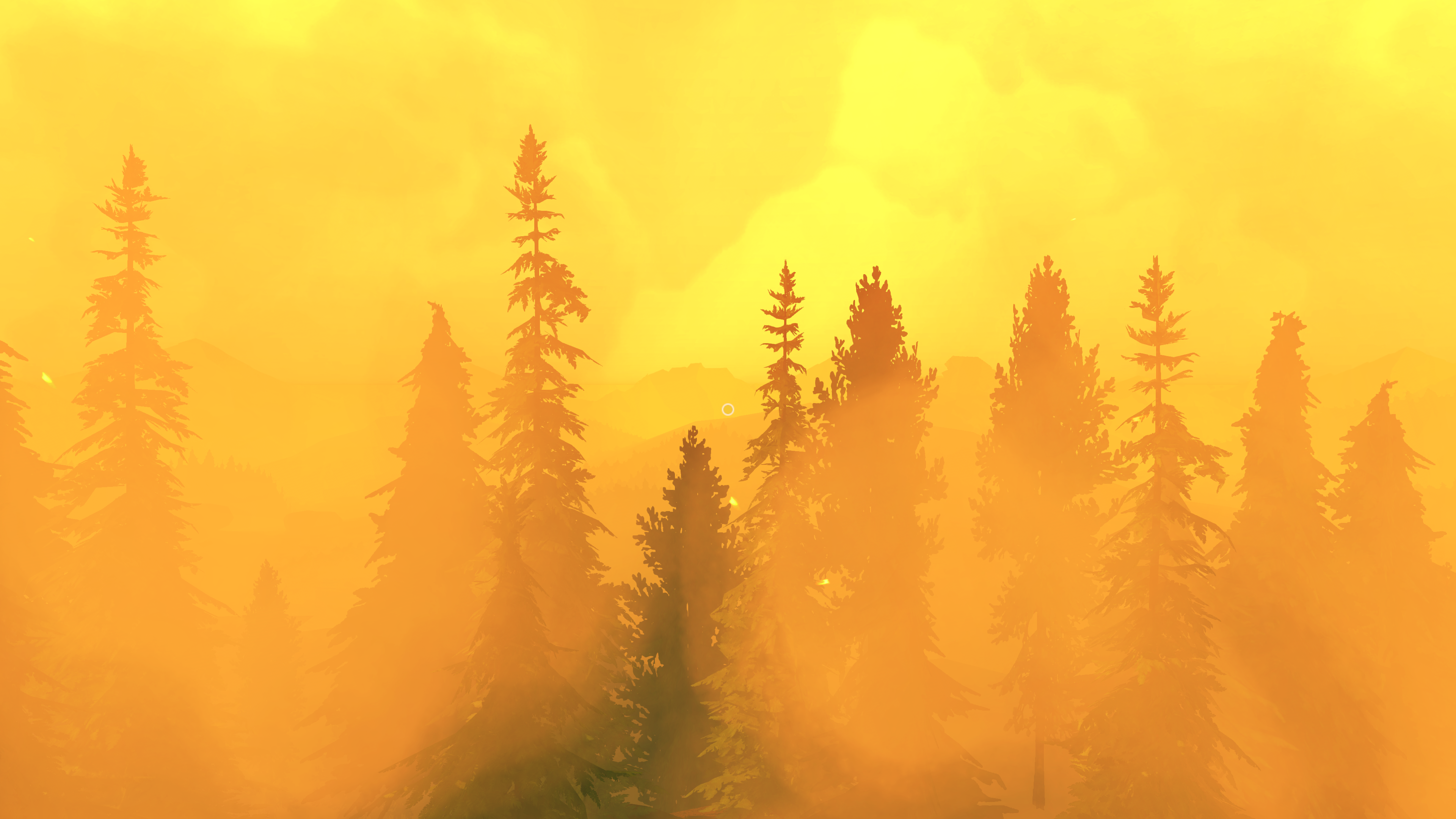
Pixel Boost is our weekly series devoted to the artistry of games, and the techniques required to run them at high resolutions.
Art direction can go a long way in creating a believable videogame world, even if it ignores realism entirely. Firewatch is a prime example, using advanced color theory and scenic framing to render the Shoshone National Forest of Wyoming. The shade of a single tree communicates the time of day and mood while staying recognizable, even silhouetted against a mesh of other props. The same lighting and color spread across every object in the environment is nothing short of astounding, especially in 4K.
Firewatch matches your monitor’s native resolution by default, so to get it running at 4K or higher, you’ll need a 4K monitor (duh) or you’ll need to change your monitor’s rendered resolution to something higher. Nvidia's DSR was a no-go in this case, so we created a custom 4K resolution and ran out desktop at 3840x2160 to grab the screens.
Artists on the Steam forums are already taking some phenomenal wide angle shots. This may not be our last Pixel Boost from the Shoshone.
There’s no way to turn off the massive circular aiming reticule while walking around just yet, which is odd for a game designed to be ogled. Even so, a quick bit of Photoshop work could turn any of these into a wonderful desktop wallpaper.
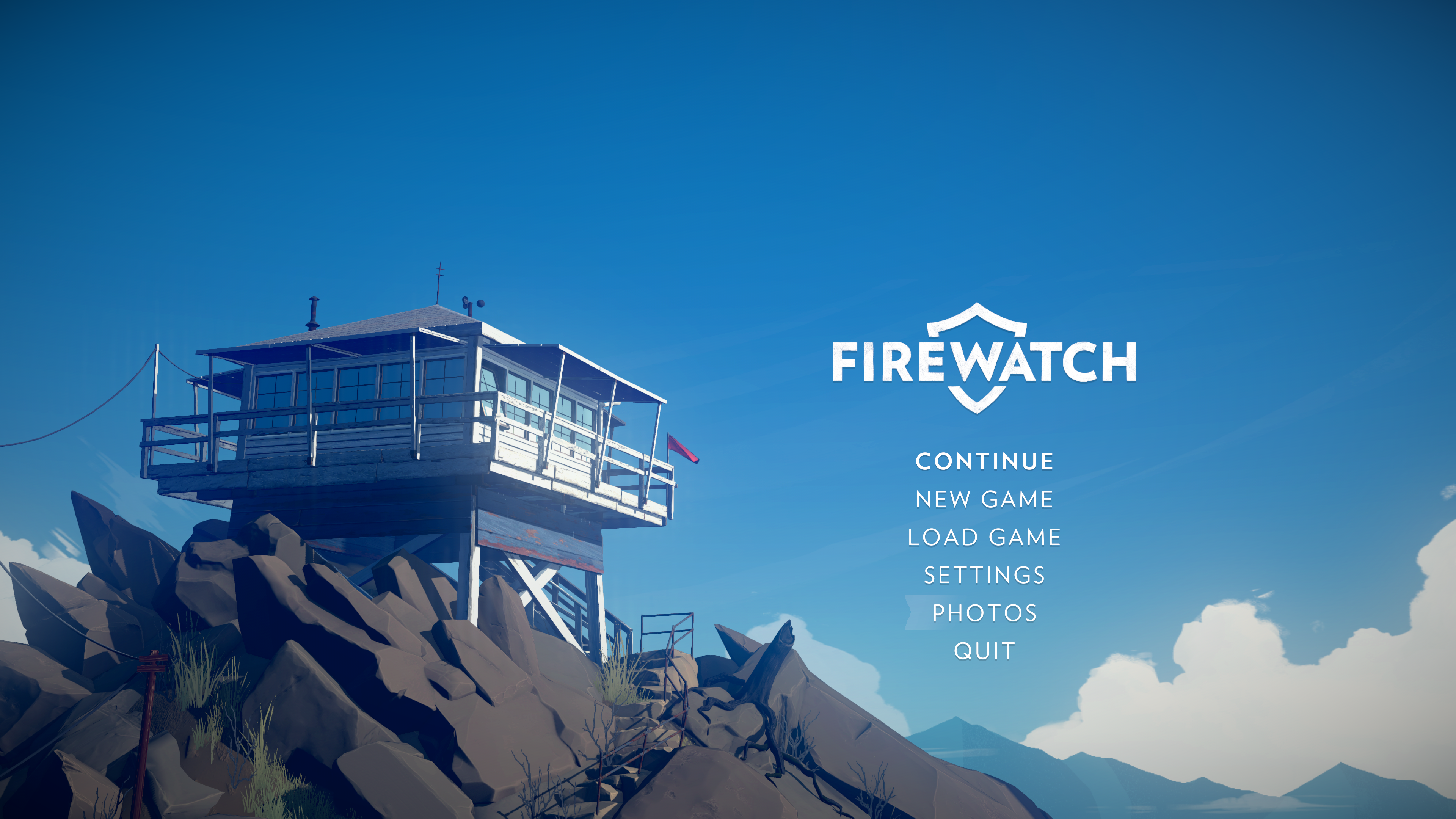
Pixel Boost is our weekly series devoted to the artistry of games, and the techniques required to run them at high resolutions.
Art direction can go a long way in creating a believable videogame world, even if it ignores realism entirely. Firewatch is a prime example, using advanced color theory and scenic framing to render the Shoshone National Forest of Wyoming. The shade of a single tree communicates the time of day and mood while staying recognizable, even silhouetted against a mesh of other props. The same lighting and color spread across every object in the environment is nothing short of astounding, especially in 4K.
Firewatch matches your monitor’s native resolution by default, so to get it running at 4K or higher, you’ll need a 4K monitor (duh) or you’ll need to change your monitor’s rendered resolution to something higher. Nvidia's DSR was a no-go in this case, so we created a custom 4K resolution and ran out desktop at 3840x2160 to grab the screens.
Artists on the Steam forums are already taking some phenomenal wide angle shots. This may not be our last Pixel Boost from the Shoshone.
There’s no way to turn off the massive circular aiming reticule while walking around just yet, which is odd for a game designed to be ogled. Even so, a quick bit of Photoshop work could turn any of these into a wonderful desktop wallpaper.
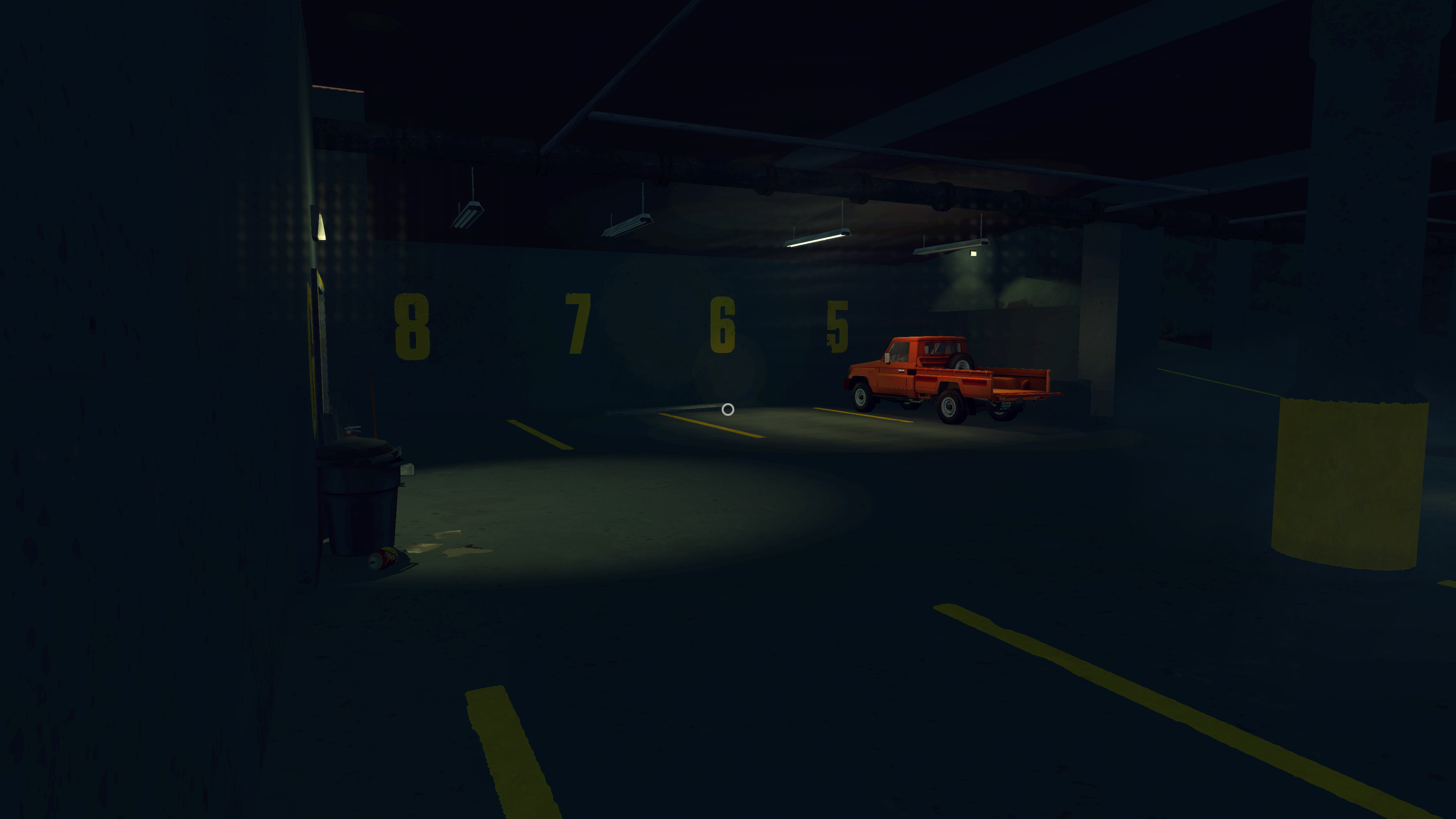
Pixel Boost is our weekly series devoted to the artistry of games, and the techniques required to run them at high resolutions.
Art direction can go a long way in creating a believable videogame world, even if it ignores realism entirely. Firewatch is a prime example, using advanced color theory and scenic framing to render the Shoshone National Forest of Wyoming. The shade of a single tree communicates the time of day and mood while staying recognizable, even silhouetted against a mesh of other props. The same lighting and color spread across every object in the environment is nothing short of astounding, especially in 4K.
Firewatch matches your monitor’s native resolution by default, so to get it running at 4K or higher, you’ll need a 4K monitor (duh) or you’ll need to change your monitor’s rendered resolution to something higher. Nvidia's DSR was a no-go in this case, so we created a custom 4K resolution and ran out desktop at 3840x2160 to grab the screens.
Artists on the Steam forums are already taking some phenomenal wide angle shots. This may not be our last Pixel Boost from the Shoshone.
There’s no way to turn off the massive circular aiming reticule while walking around just yet, which is odd for a game designed to be ogled. Even so, a quick bit of Photoshop work could turn any of these into a wonderful desktop wallpaper.
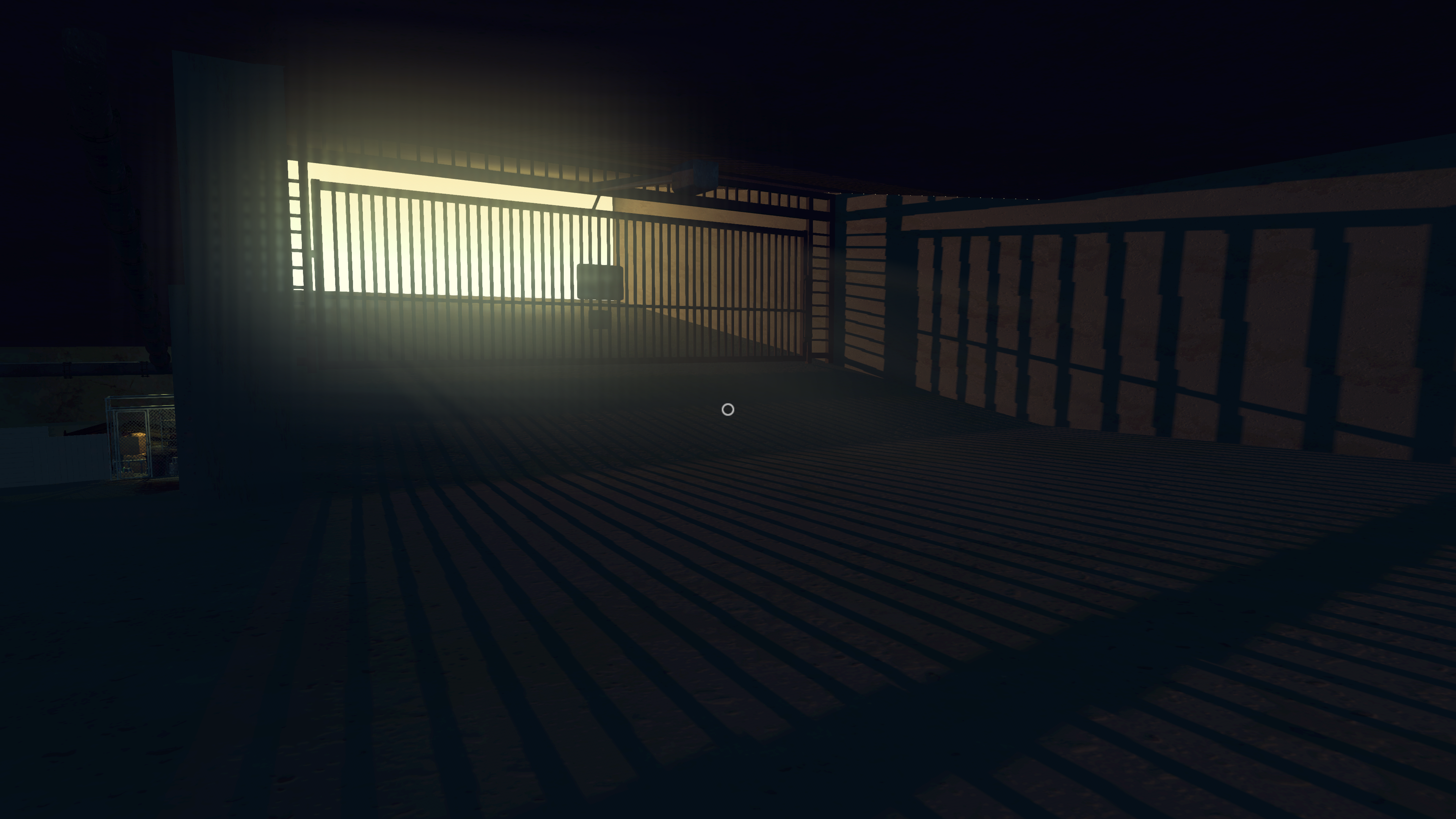
Pixel Boost is our weekly series devoted to the artistry of games, and the techniques required to run them at high resolutions.
Art direction can go a long way in creating a believable videogame world, even if it ignores realism entirely. Firewatch is a prime example, using advanced color theory and scenic framing to render the Shoshone National Forest of Wyoming. The shade of a single tree communicates the time of day and mood while staying recognizable, even silhouetted against a mesh of other props. The same lighting and color spread across every object in the environment is nothing short of astounding, especially in 4K.
Firewatch matches your monitor’s native resolution by default, so to get it running at 4K or higher, you’ll need a 4K monitor (duh) or you’ll need to change your monitor’s rendered resolution to something higher. Nvidia's DSR was a no-go in this case, so we created a custom 4K resolution and ran out desktop at 3840x2160 to grab the screens.
Artists on the Steam forums are already taking some phenomenal wide angle shots. This may not be our last Pixel Boost from the Shoshone.
There’s no way to turn off the massive circular aiming reticule while walking around just yet, which is odd for a game designed to be ogled. Even so, a quick bit of Photoshop work could turn any of these into a wonderful desktop wallpaper.
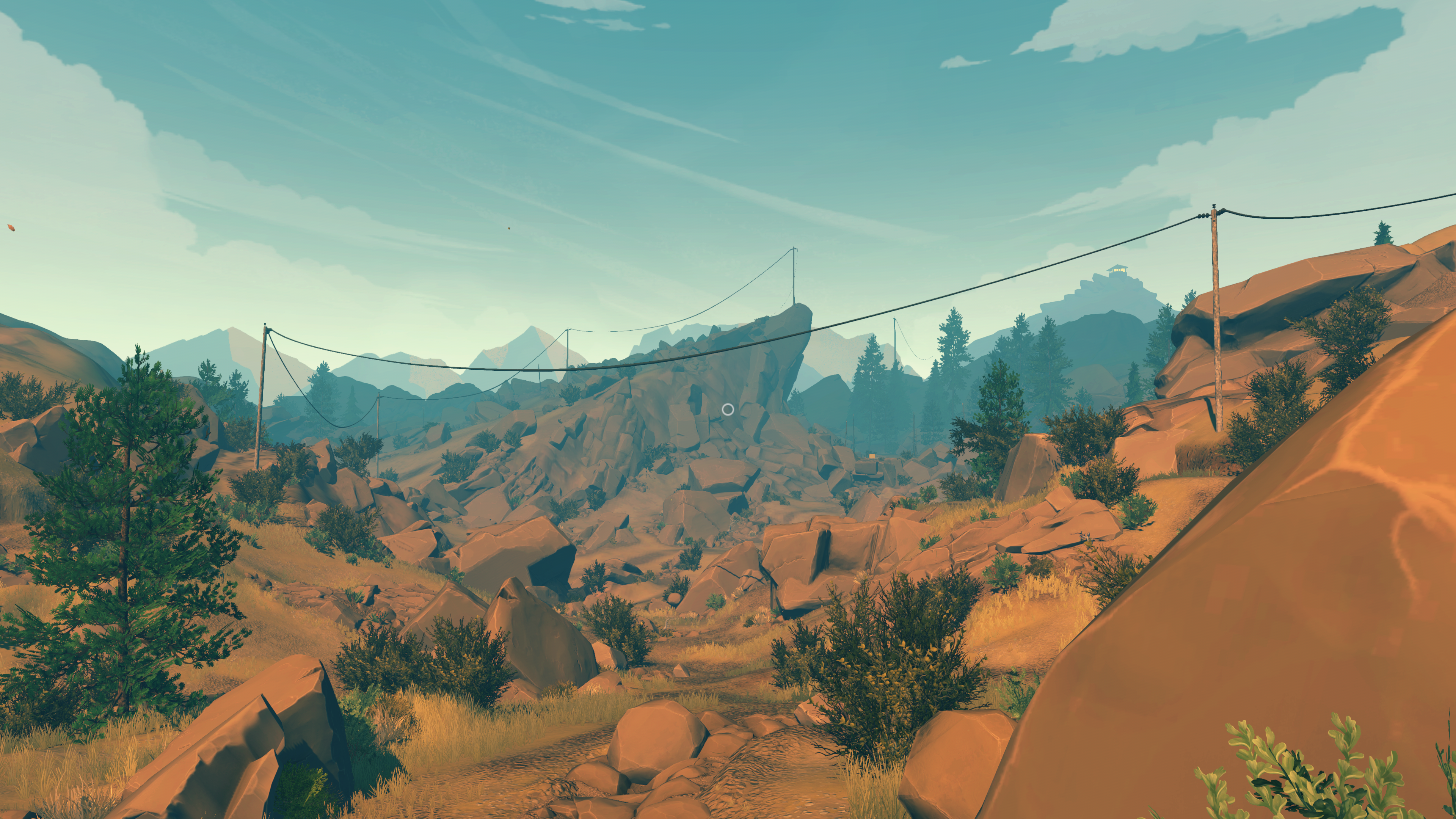
Pixel Boost is our weekly series devoted to the artistry of games, and the techniques required to run them at high resolutions.
Art direction can go a long way in creating a believable videogame world, even if it ignores realism entirely. Firewatch is a prime example, using advanced color theory and scenic framing to render the Shoshone National Forest of Wyoming. The shade of a single tree communicates the time of day and mood while staying recognizable, even silhouetted against a mesh of other props. The same lighting and color spread across every object in the environment is nothing short of astounding, especially in 4K.
Firewatch matches your monitor’s native resolution by default, so to get it running at 4K or higher, you’ll need a 4K monitor (duh) or you’ll need to change your monitor’s rendered resolution to something higher. Nvidia's DSR was a no-go in this case, so we created a custom 4K resolution and ran out desktop at 3840x2160 to grab the screens.
Artists on the Steam forums are already taking some phenomenal wide angle shots. This may not be our last Pixel Boost from the Shoshone.
There’s no way to turn off the massive circular aiming reticule while walking around just yet, which is odd for a game designed to be ogled. Even so, a quick bit of Photoshop work could turn any of these into a wonderful desktop wallpaper.
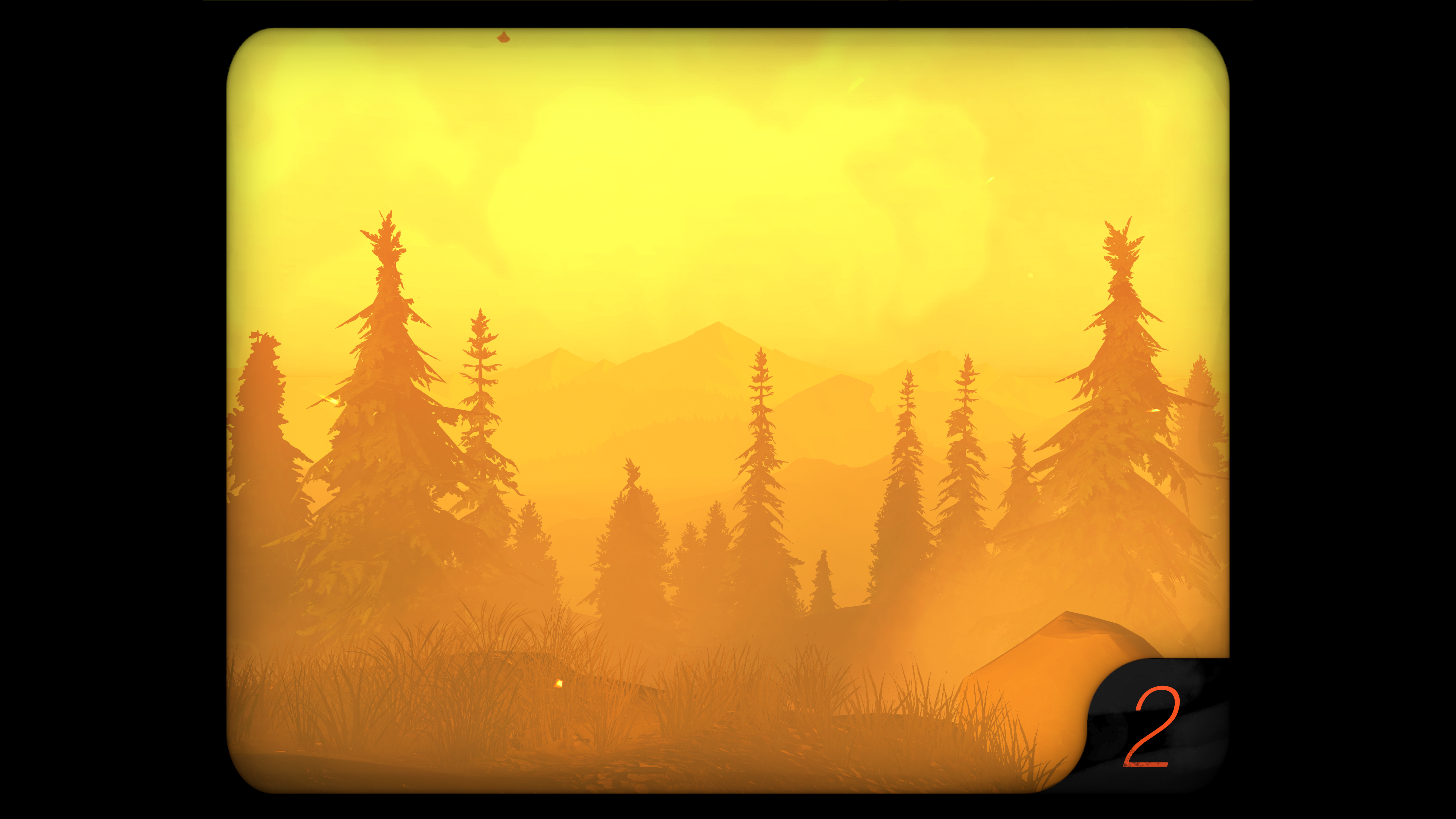
Pixel Boost is our weekly series devoted to the artistry of games, and the techniques required to run them at high resolutions.
Art direction can go a long way in creating a believable videogame world, even if it ignores realism entirely. Firewatch is a prime example, using advanced color theory and scenic framing to render the Shoshone National Forest of Wyoming. The shade of a single tree communicates the time of day and mood while staying recognizable, even silhouetted against a mesh of other props. The same lighting and color spread across every object in the environment is nothing short of astounding, especially in 4K.
Firewatch matches your monitor’s native resolution by default, so to get it running at 4K or higher, you’ll need a 4K monitor (duh) or you’ll need to change your monitor’s rendered resolution to something higher. Nvidia's DSR was a no-go in this case, so we created a custom 4K resolution and ran out desktop at 3840x2160 to grab the screens.
Artists on the Steam forums are already taking some phenomenal wide angle shots. This may not be our last Pixel Boost from the Shoshone.
There’s no way to turn off the massive circular aiming reticule while walking around just yet, which is odd for a game designed to be ogled. Even so, a quick bit of Photoshop work could turn any of these into a wonderful desktop wallpaper.
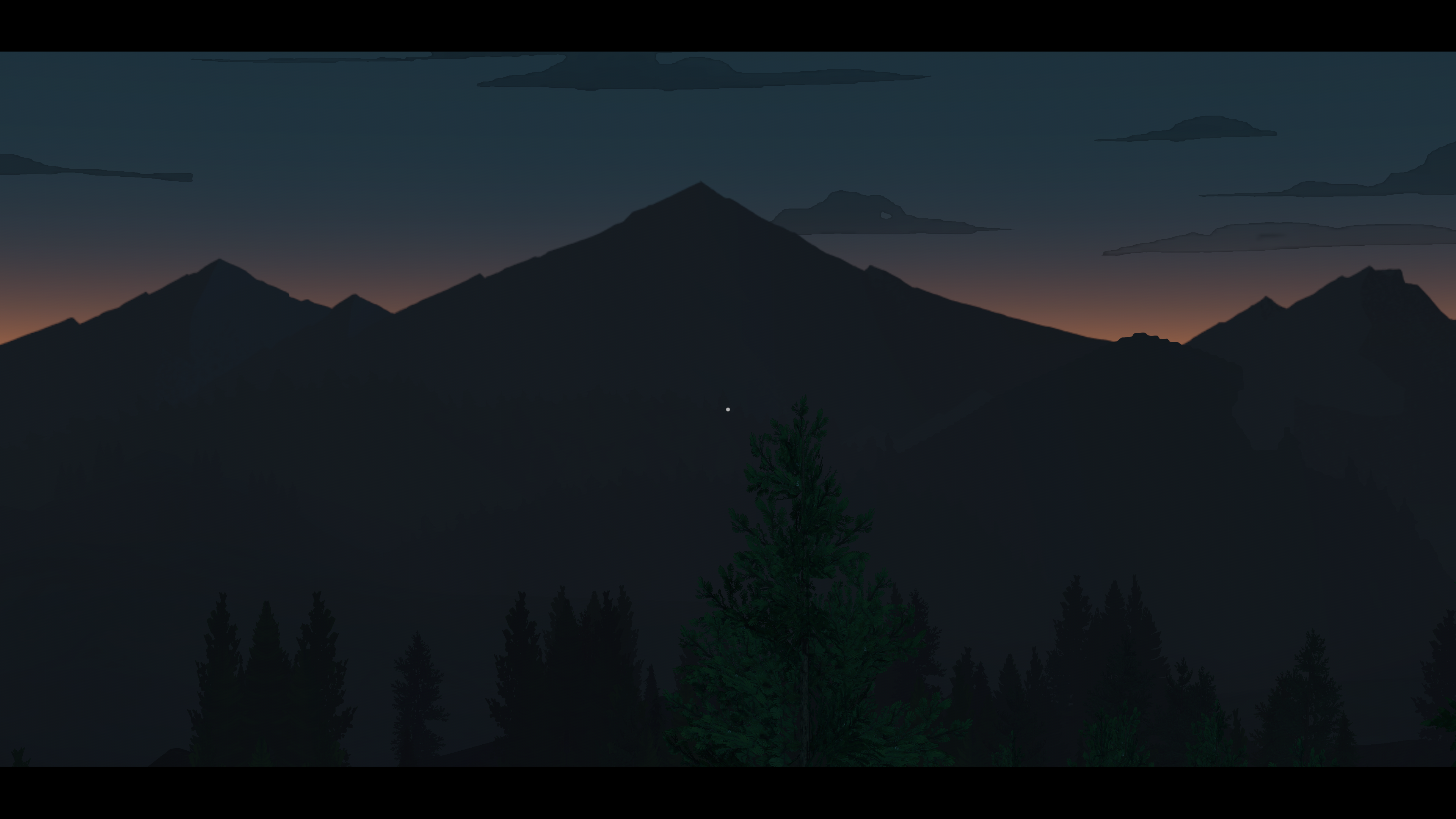
Pixel Boost is our weekly series devoted to the artistry of games, and the techniques required to run them at high resolutions.
Art direction can go a long way in creating a believable videogame world, even if it ignores realism entirely. Firewatch is a prime example, using advanced color theory and scenic framing to render the Shoshone National Forest of Wyoming. The shade of a single tree communicates the time of day and mood while staying recognizable, even silhouetted against a mesh of other props. The same lighting and color spread across every object in the environment is nothing short of astounding, especially in 4K.
Firewatch matches your monitor’s native resolution by default, so to get it running at 4K or higher, you’ll need a 4K monitor (duh) or you’ll need to change your monitor’s rendered resolution to something higher. Nvidia's DSR was a no-go in this case, so we created a custom 4K resolution and ran out desktop at 3840x2160 to grab the screens.
Artists on the Steam forums are already taking some phenomenal wide angle shots. This may not be our last Pixel Boost from the Shoshone.
There’s no way to turn off the massive circular aiming reticule while walking around just yet, which is odd for a game designed to be ogled. Even so, a quick bit of Photoshop work could turn any of these into a wonderful desktop wallpaper.
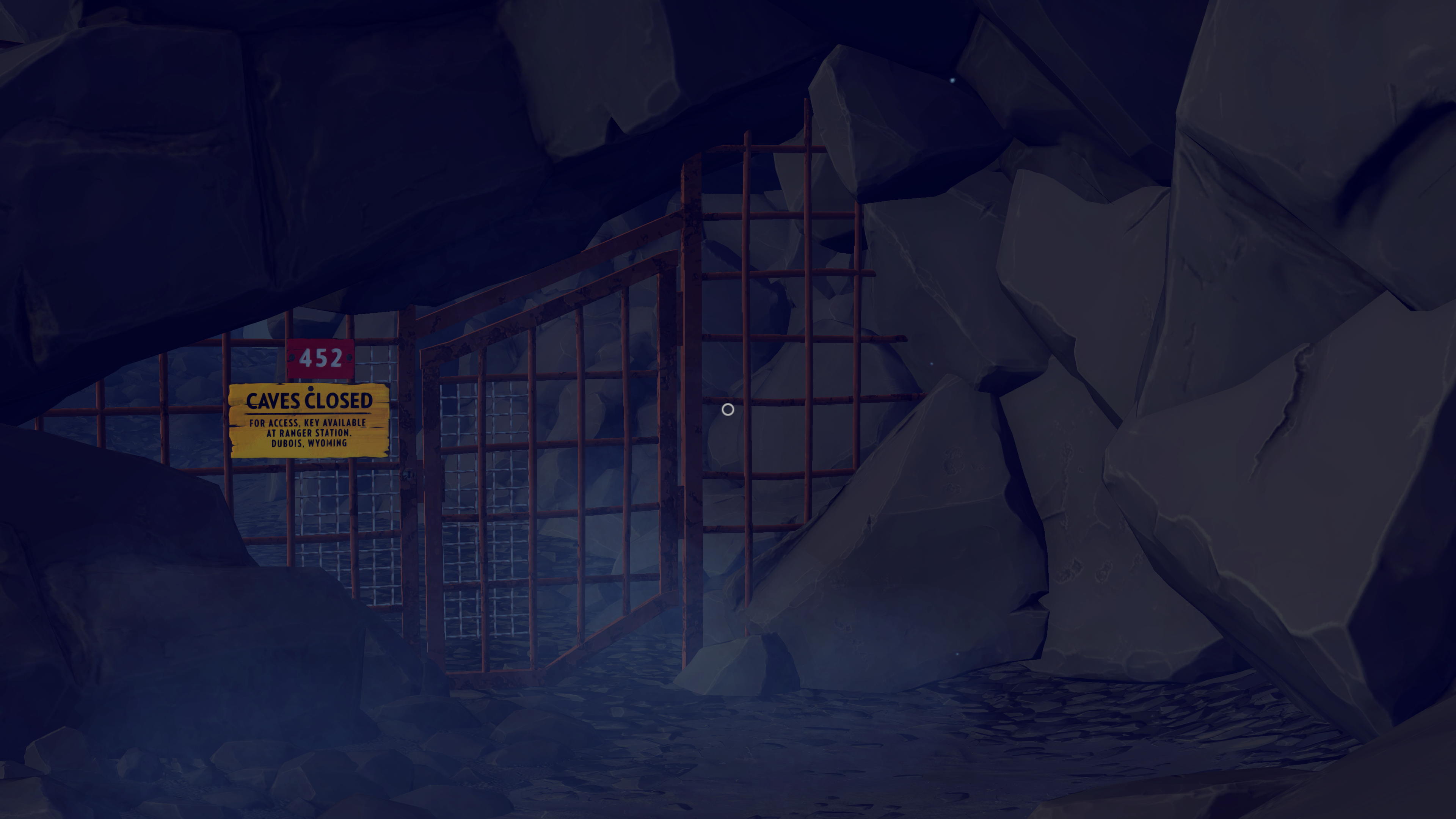
Pixel Boost is our weekly series devoted to the artistry of games, and the techniques required to run them at high resolutions.
Art direction can go a long way in creating a believable videogame world, even if it ignores realism entirely. Firewatch is a prime example, using advanced color theory and scenic framing to render the Shoshone National Forest of Wyoming. The shade of a single tree communicates the time of day and mood while staying recognizable, even silhouetted against a mesh of other props. The same lighting and color spread across every object in the environment is nothing short of astounding, especially in 4K.
Firewatch matches your monitor’s native resolution by default, so to get it running at 4K or higher, you’ll need a 4K monitor (duh) or you’ll need to change your monitor’s rendered resolution to something higher. Nvidia's DSR was a no-go in this case, so we created a custom 4K resolution and ran out desktop at 3840x2160 to grab the screens.
Artists on the Steam forums are already taking some phenomenal wide angle shots. This may not be our last Pixel Boost from the Shoshone.
There’s no way to turn off the massive circular aiming reticule while walking around just yet, which is odd for a game designed to be ogled. Even so, a quick bit of Photoshop work could turn any of these into a wonderful desktop wallpaper.
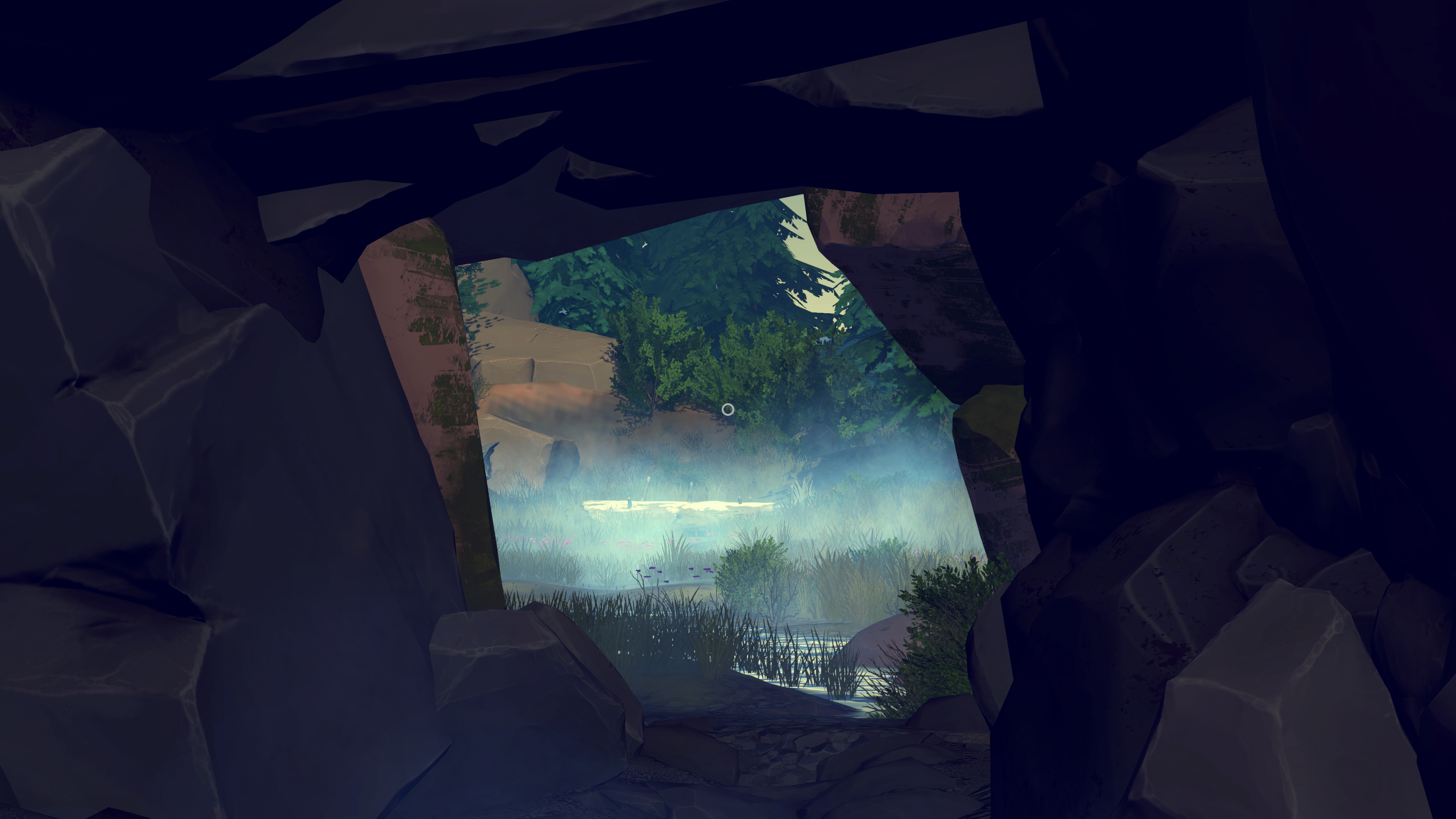
Pixel Boost is our weekly series devoted to the artistry of games, and the techniques required to run them at high resolutions.
Art direction can go a long way in creating a believable videogame world, even if it ignores realism entirely. Firewatch is a prime example, using advanced color theory and scenic framing to render the Shoshone National Forest of Wyoming. The shade of a single tree communicates the time of day and mood while staying recognizable, even silhouetted against a mesh of other props. The same lighting and color spread across every object in the environment is nothing short of astounding, especially in 4K.
Firewatch matches your monitor’s native resolution by default, so to get it running at 4K or higher, you’ll need a 4K monitor (duh) or you’ll need to change your monitor’s rendered resolution to something higher. Nvidia's DSR was a no-go in this case, so we created a custom 4K resolution and ran out desktop at 3840x2160 to grab the screens.
Artists on the Steam forums are already taking some phenomenal wide angle shots. This may not be our last Pixel Boost from the Shoshone.
There’s no way to turn off the massive circular aiming reticule while walking around just yet, which is odd for a game designed to be ogled. Even so, a quick bit of Photoshop work could turn any of these into a wonderful desktop wallpaper.

Pixel Boost is our weekly series devoted to the artistry of games, and the techniques required to run them at high resolutions.
Art direction can go a long way in creating a believable videogame world, even if it ignores realism entirely. Firewatch is a prime example, using advanced color theory and scenic framing to render the Shoshone National Forest of Wyoming. The shade of a single tree communicates the time of day and mood while staying recognizable, even silhouetted against a mesh of other props. The same lighting and color spread across every object in the environment is nothing short of astounding, especially in 4K.
Firewatch matches your monitor’s native resolution by default, so to get it running at 4K or higher, you’ll need a 4K monitor (duh) or you’ll need to change your monitor’s rendered resolution to something higher. Nvidia's DSR was a no-go in this case, so we created a custom 4K resolution and ran out desktop at 3840x2160 to grab the screens.
Artists on the Steam forums are already taking some phenomenal wide angle shots. This may not be our last Pixel Boost from the Shoshone.
There’s no way to turn off the massive circular aiming reticule while walking around just yet, which is odd for a game designed to be ogled. Even so, a quick bit of Photoshop work could turn any of these into a wonderful desktop wallpaper.

Pixel Boost is our weekly series devoted to the artistry of games, and the techniques required to run them at high resolutions.
Art direction can go a long way in creating a believable videogame world, even if it ignores realism entirely. Firewatch is a prime example, using advanced color theory and scenic framing to render the Shoshone National Forest of Wyoming. The shade of a single tree communicates the time of day and mood while staying recognizable, even silhouetted against a mesh of other props. The same lighting and color spread across every object in the environment is nothing short of astounding, especially in 4K.
Firewatch matches your monitor’s native resolution by default, so to get it running at 4K or higher, you’ll need a 4K monitor (duh) or you’ll need to change your monitor’s rendered resolution to something higher. Nvidia's DSR was a no-go in this case, so we created a custom 4K resolution and ran out desktop at 3840x2160 to grab the screens.
Artists on the Steam forums are already taking some phenomenal wide angle shots. This may not be our last Pixel Boost from the Shoshone.
There’s no way to turn off the massive circular aiming reticule while walking around just yet, which is odd for a game designed to be ogled. Even so, a quick bit of Photoshop work could turn any of these into a wonderful desktop wallpaper.
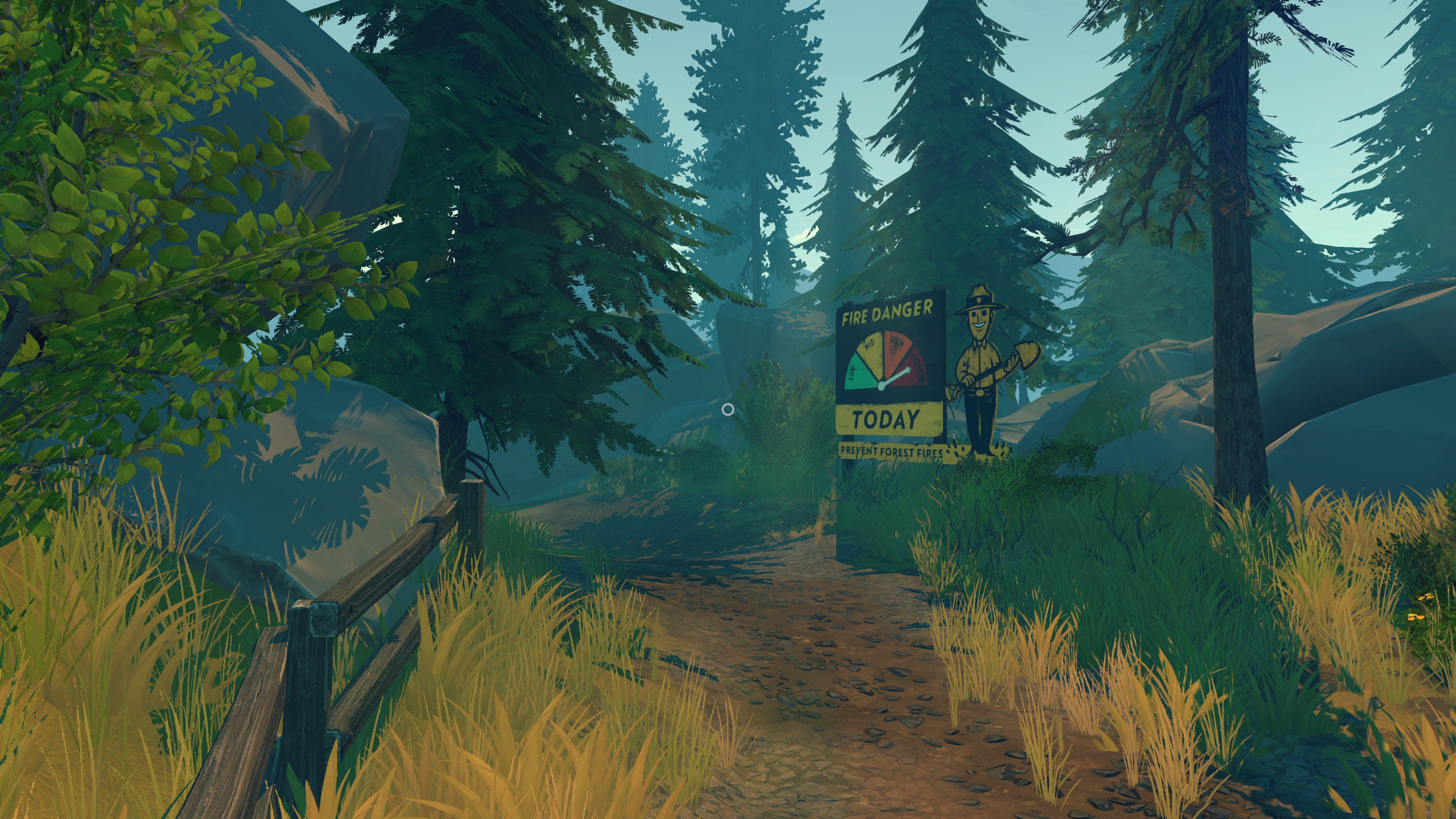
Pixel Boost is our weekly series devoted to the artistry of games, and the techniques required to run them at high resolutions.
Art direction can go a long way in creating a believable videogame world, even if it ignores realism entirely. Firewatch is a prime example, using advanced color theory and scenic framing to render the Shoshone National Forest of Wyoming. The shade of a single tree communicates the time of day and mood while staying recognizable, even silhouetted against a mesh of other props. The same lighting and color spread across every object in the environment is nothing short of astounding, especially in 4K.
Firewatch matches your monitor’s native resolution by default, so to get it running at 4K or higher, you’ll need a 4K monitor (duh) or you’ll need to change your monitor’s rendered resolution to something higher. Nvidia's DSR was a no-go in this case, so we created a custom 4K resolution and ran out desktop at 3840x2160 to grab the screens.
Artists on the Steam forums are already taking some phenomenal wide angle shots. This may not be our last Pixel Boost from the Shoshone.
There’s no way to turn off the massive circular aiming reticule while walking around just yet, which is odd for a game designed to be ogled. Even so, a quick bit of Photoshop work could turn any of these into a wonderful desktop wallpaper.

Pixel Boost is our weekly series devoted to the artistry of games, and the techniques required to run them at high resolutions.
Art direction can go a long way in creating a believable videogame world, even if it ignores realism entirely. Firewatch is a prime example, using advanced color theory and scenic framing to render the Shoshone National Forest of Wyoming. The shade of a single tree communicates the time of day and mood while staying recognizable, even silhouetted against a mesh of other props. The same lighting and color spread across every object in the environment is nothing short of astounding, especially in 4K.
Firewatch matches your monitor’s native resolution by default, so to get it running at 4K or higher, you’ll need a 4K monitor (duh) or you’ll need to change your monitor’s rendered resolution to something higher. Nvidia's DSR was a no-go in this case, so we created a custom 4K resolution and ran out desktop at 3840x2160 to grab the screens.
Artists on the Steam forums are already taking some phenomenal wide angle shots. This may not be our last Pixel Boost from the Shoshone.
There’s no way to turn off the massive circular aiming reticule while walking around just yet, which is odd for a game designed to be ogled. Even so, a quick bit of Photoshop work could turn any of these into a wonderful desktop wallpaper.

Pixel Boost is our weekly series devoted to the artistry of games, and the techniques required to run them at high resolutions.
Art direction can go a long way in creating a believable videogame world, even if it ignores realism entirely. Firewatch is a prime example, using advanced color theory and scenic framing to render the Shoshone National Forest of Wyoming. The shade of a single tree communicates the time of day and mood while staying recognizable, even silhouetted against a mesh of other props. The same lighting and color spread across every object in the environment is nothing short of astounding, especially in 4K.
Firewatch matches your monitor’s native resolution by default, so to get it running at 4K or higher, you’ll need a 4K monitor (duh) or you’ll need to change your monitor’s rendered resolution to something higher. Nvidia's DSR was a no-go in this case, so we created a custom 4K resolution and ran out desktop at 3840x2160 to grab the screens.
Artists on the Steam forums are already taking some phenomenal wide angle shots. This may not be our last Pixel Boost from the Shoshone.
There’s no way to turn off the massive circular aiming reticule while walking around just yet, which is odd for a game designed to be ogled. Even so, a quick bit of Photoshop work could turn any of these into a wonderful desktop wallpaper.

Pixel Boost is our weekly series devoted to the artistry of games, and the techniques required to run them at high resolutions.
Art direction can go a long way in creating a believable videogame world, even if it ignores realism entirely. Firewatch is a prime example, using advanced color theory and scenic framing to render the Shoshone National Forest of Wyoming. The shade of a single tree communicates the time of day and mood while staying recognizable, even silhouetted against a mesh of other props. The same lighting and color spread across every object in the environment is nothing short of astounding, especially in 4K.
Firewatch matches your monitor’s native resolution by default, so to get it running at 4K or higher, you’ll need a 4K monitor (duh) or you’ll need to change your monitor’s rendered resolution to something higher. Nvidia's DSR was a no-go in this case, so we created a custom 4K resolution and ran out desktop at 3840x2160 to grab the screens.
Artists on the Steam forums are already taking some phenomenal wide angle shots. This may not be our last Pixel Boost from the Shoshone.
There’s no way to turn off the massive circular aiming reticule while walking around just yet, which is odd for a game designed to be ogled. Even so, a quick bit of Photoshop work could turn any of these into a wonderful desktop wallpaper.
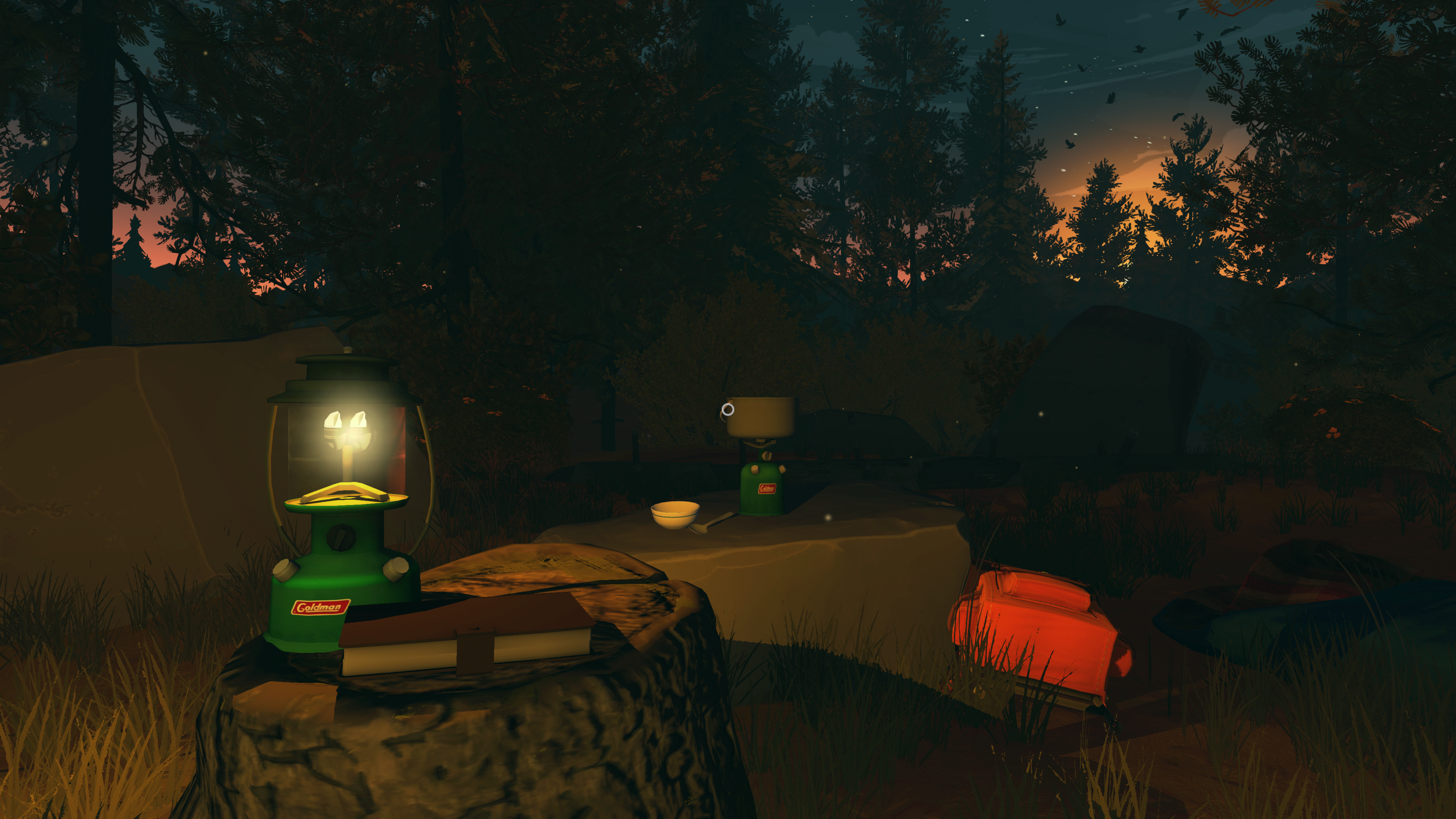
Pixel Boost is our weekly series devoted to the artistry of games, and the techniques required to run them at high resolutions.
Art direction can go a long way in creating a believable videogame world, even if it ignores realism entirely. Firewatch is a prime example, using advanced color theory and scenic framing to render the Shoshone National Forest of Wyoming. The shade of a single tree communicates the time of day and mood while staying recognizable, even silhouetted against a mesh of other props. The same lighting and color spread across every object in the environment is nothing short of astounding, especially in 4K.
Firewatch matches your monitor’s native resolution by default, so to get it running at 4K or higher, you’ll need a 4K monitor (duh) or you’ll need to change your monitor’s rendered resolution to something higher. Nvidia's DSR was a no-go in this case, so we created a custom 4K resolution and ran out desktop at 3840x2160 to grab the screens.
Artists on the Steam forums are already taking some phenomenal wide angle shots. This may not be our last Pixel Boost from the Shoshone.
There’s no way to turn off the massive circular aiming reticule while walking around just yet, which is odd for a game designed to be ogled. Even so, a quick bit of Photoshop work could turn any of these into a wonderful desktop wallpaper.
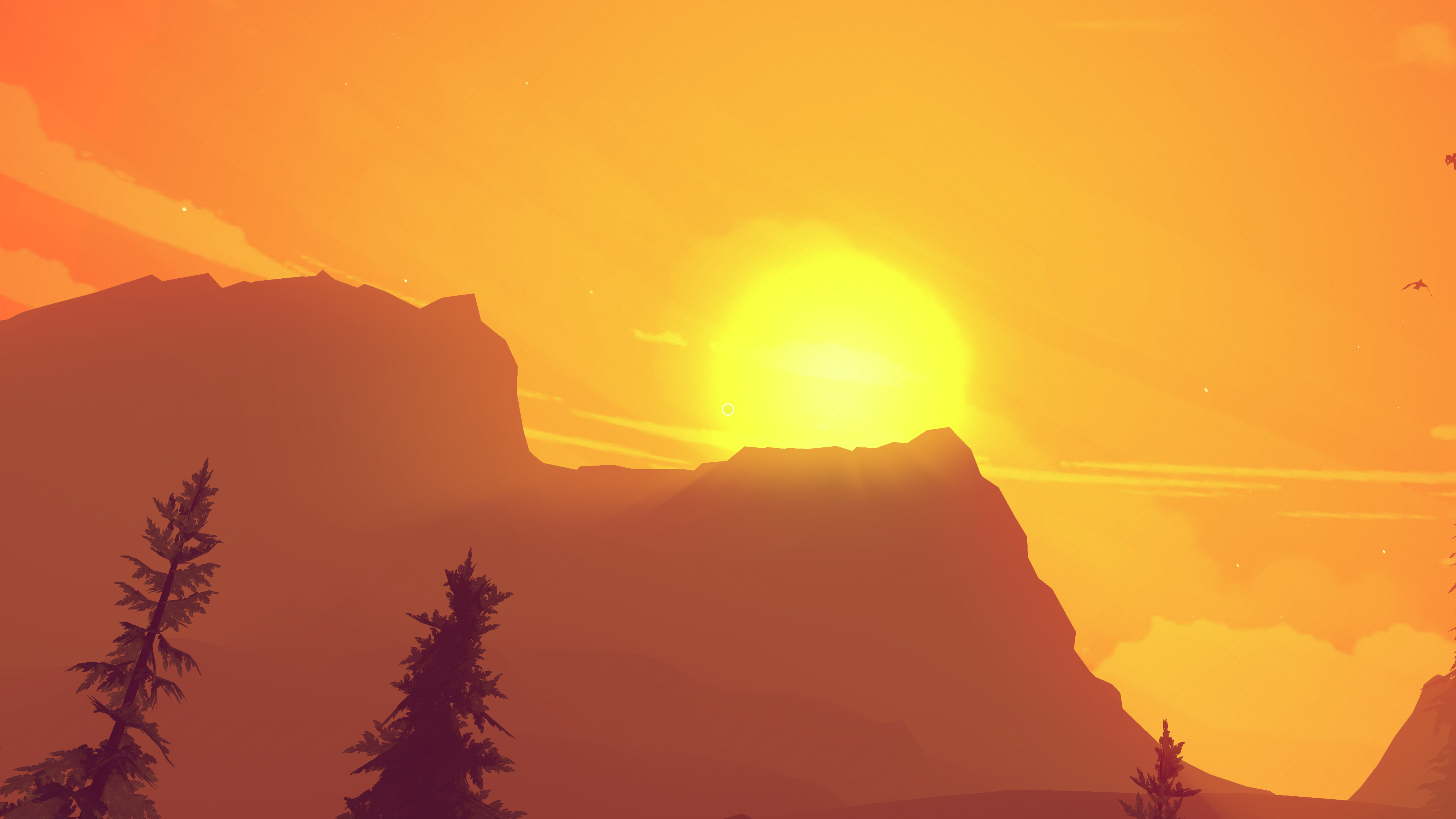
Pixel Boost is our weekly series devoted to the artistry of games, and the techniques required to run them at high resolutions.
Art direction can go a long way in creating a believable videogame world, even if it ignores realism entirely. Firewatch is a prime example, using advanced color theory and scenic framing to render the Shoshone National Forest of Wyoming. The shade of a single tree communicates the time of day and mood while staying recognizable, even silhouetted against a mesh of other props. The same lighting and color spread across every object in the environment is nothing short of astounding, especially in 4K.
Firewatch matches your monitor’s native resolution by default, so to get it running at 4K or higher, you’ll need a 4K monitor (duh) or you’ll need to change your monitor’s rendered resolution to something higher. Nvidia's DSR was a no-go in this case, so we created a custom 4K resolution and ran out desktop at 3840x2160 to grab the screens.
Artists on the Steam forums are already taking some phenomenal wide angle shots. This may not be our last Pixel Boost from the Shoshone.
There’s no way to turn off the massive circular aiming reticule while walking around just yet, which is odd for a game designed to be ogled. Even so, a quick bit of Photoshop work could turn any of these into a wonderful desktop wallpaper.

Pixel Boost is our weekly series devoted to the artistry of games, and the techniques required to run them at high resolutions.
Art direction can go a long way in creating a believable videogame world, even if it ignores realism entirely. Firewatch is a prime example, using advanced color theory and scenic framing to render the Shoshone National Forest of Wyoming. The shade of a single tree communicates the time of day and mood while staying recognizable, even silhouetted against a mesh of other props. The same lighting and color spread across every object in the environment is nothing short of astounding, especially in 4K.
Firewatch matches your monitor’s native resolution by default, so to get it running at 4K or higher, you’ll need a 4K monitor (duh) or you’ll need to change your monitor’s rendered resolution to something higher. Nvidia's DSR was a no-go in this case, so we created a custom 4K resolution and ran out desktop at 3840x2160 to grab the screens.
Artists on the Steam forums are already taking some phenomenal wide angle shots. This may not be our last Pixel Boost from the Shoshone.
There’s no way to turn off the massive circular aiming reticule while walking around just yet, which is odd for a game designed to be ogled. Even so, a quick bit of Photoshop work could turn any of these into a wonderful desktop wallpaper.
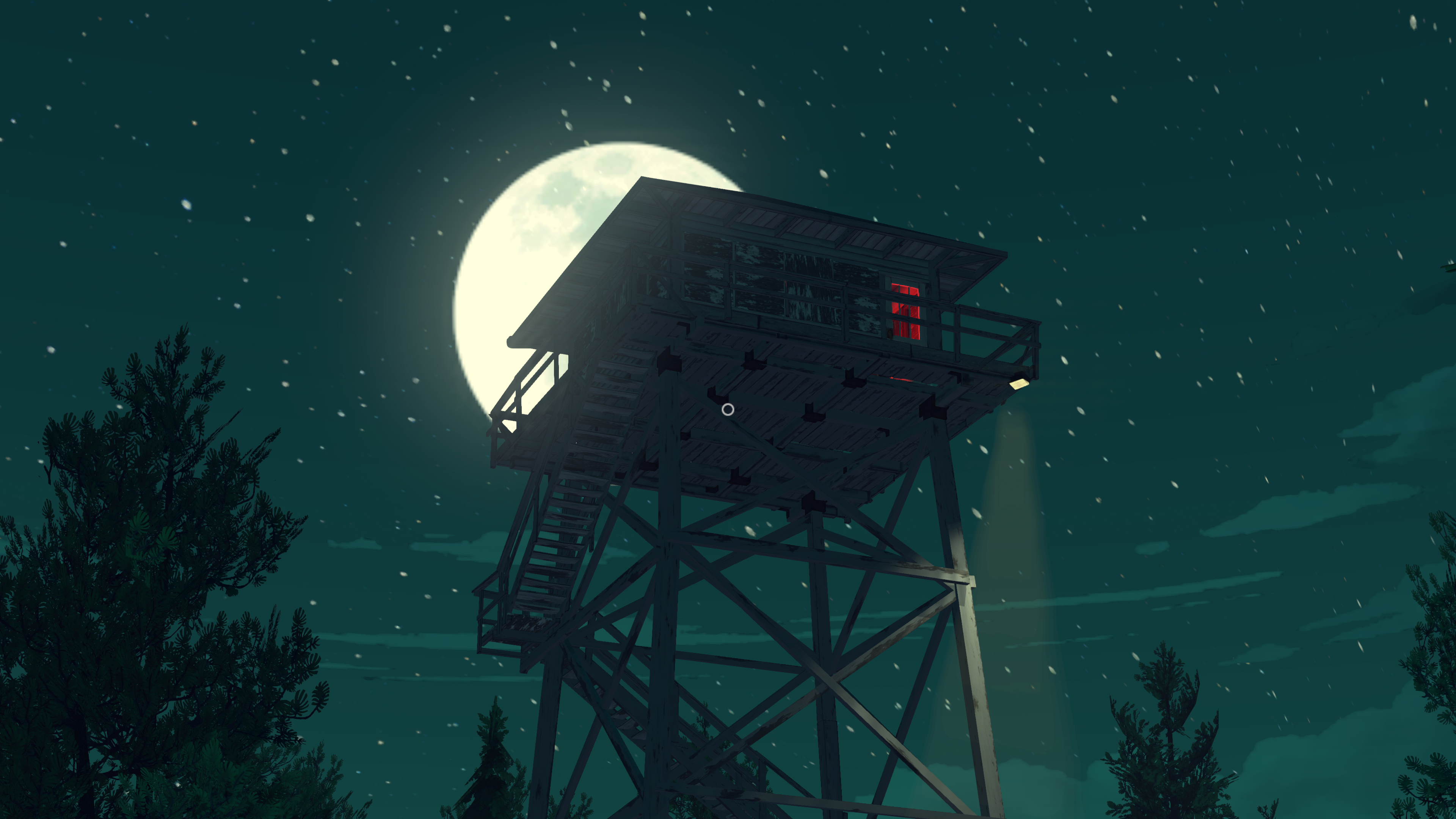
Pixel Boost is our weekly series devoted to the artistry of games, and the techniques required to run them at high resolutions.
Art direction can go a long way in creating a believable videogame world, even if it ignores realism entirely. Firewatch is a prime example, using advanced color theory and scenic framing to render the Shoshone National Forest of Wyoming. The shade of a single tree communicates the time of day and mood while staying recognizable, even silhouetted against a mesh of other props. The same lighting and color spread across every object in the environment is nothing short of astounding, especially in 4K.
Firewatch matches your monitor’s native resolution by default, so to get it running at 4K or higher, you’ll need a 4K monitor (duh) or you’ll need to change your monitor’s rendered resolution to something higher. Nvidia's DSR was a no-go in this case, so we created a custom 4K resolution and ran out desktop at 3840x2160 to grab the screens.
Artists on the Steam forums are already taking some phenomenal wide angle shots. This may not be our last Pixel Boost from the Shoshone.
There’s no way to turn off the massive circular aiming reticule while walking around just yet, which is odd for a game designed to be ogled. Even so, a quick bit of Photoshop work could turn any of these into a wonderful desktop wallpaper.
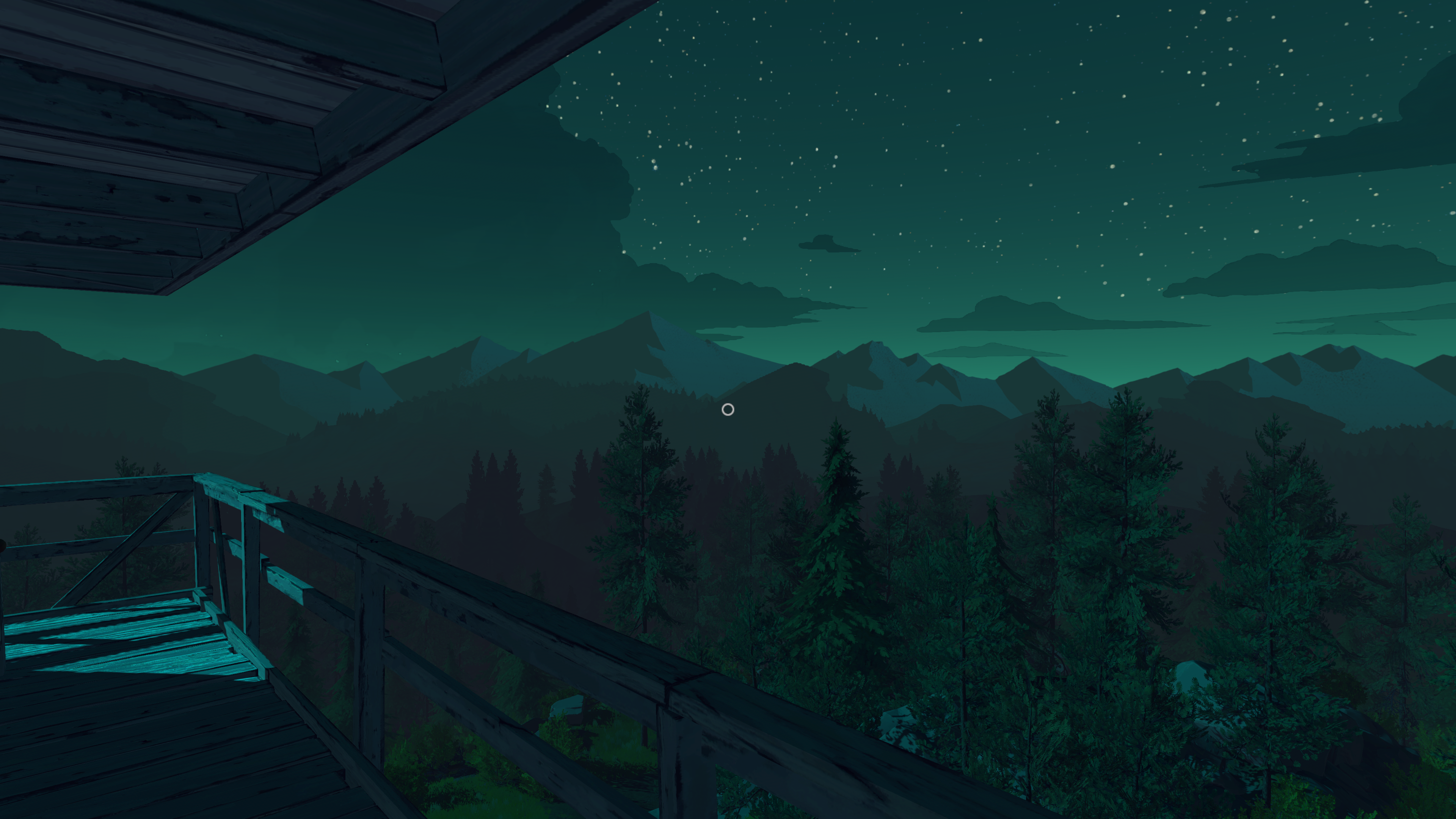
Pixel Boost is our weekly series devoted to the artistry of games, and the techniques required to run them at high resolutions.
Art direction can go a long way in creating a believable videogame world, even if it ignores realism entirely. Firewatch is a prime example, using advanced color theory and scenic framing to render the Shoshone National Forest of Wyoming. The shade of a single tree communicates the time of day and mood while staying recognizable, even silhouetted against a mesh of other props. The same lighting and color spread across every object in the environment is nothing short of astounding, especially in 4K.
Firewatch matches your monitor’s native resolution by default, so to get it running at 4K or higher, you’ll need a 4K monitor (duh) or you’ll need to change your monitor’s rendered resolution to something higher. Nvidia's DSR was a no-go in this case, so we created a custom 4K resolution and ran out desktop at 3840x2160 to grab the screens.
Artists on the Steam forums are already taking some phenomenal wide angle shots. This may not be our last Pixel Boost from the Shoshone.
There’s no way to turn off the massive circular aiming reticule while walking around just yet, which is odd for a game designed to be ogled. Even so, a quick bit of Photoshop work could turn any of these into a wonderful desktop wallpaper.
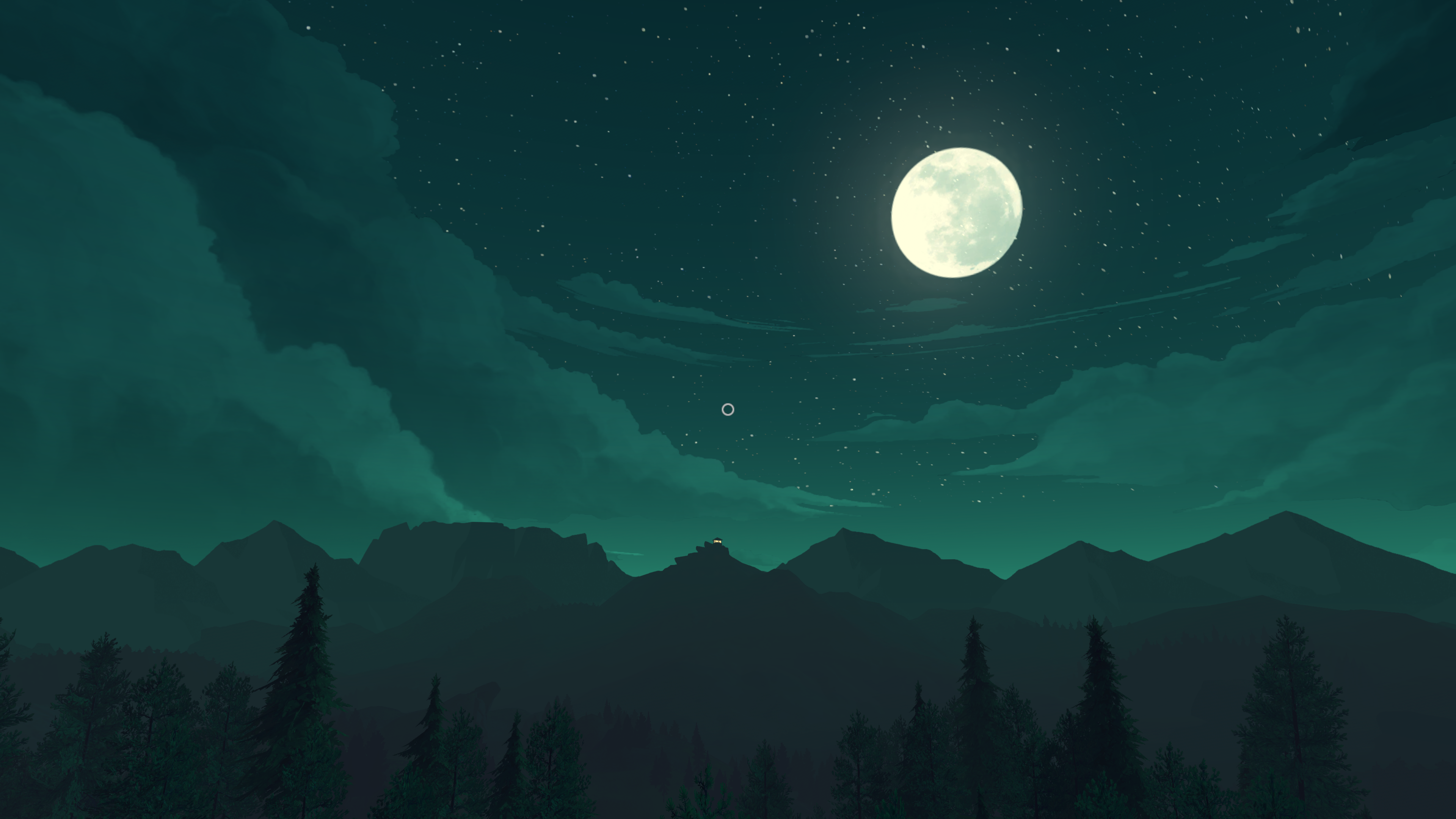
Pixel Boost is our weekly series devoted to the artistry of games, and the techniques required to run them at high resolutions.
Art direction can go a long way in creating a believable videogame world, even if it ignores realism entirely. Firewatch is a prime example, using advanced color theory and scenic framing to render the Shoshone National Forest of Wyoming. The shade of a single tree communicates the time of day and mood while staying recognizable, even silhouetted against a mesh of other props. The same lighting and color spread across every object in the environment is nothing short of astounding, especially in 4K.
Firewatch matches your monitor’s native resolution by default, so to get it running at 4K or higher, you’ll need a 4K monitor (duh) or you’ll need to change your monitor’s rendered resolution to something higher. Nvidia's DSR was a no-go in this case, so we created a custom 4K resolution and ran out desktop at 3840x2160 to grab the screens.
Artists on the Steam forums are already taking some phenomenal wide angle shots. This may not be our last Pixel Boost from the Shoshone.
There’s no way to turn off the massive circular aiming reticule while walking around just yet, which is odd for a game designed to be ogled. Even so, a quick bit of Photoshop work could turn any of these into a wonderful desktop wallpaper.
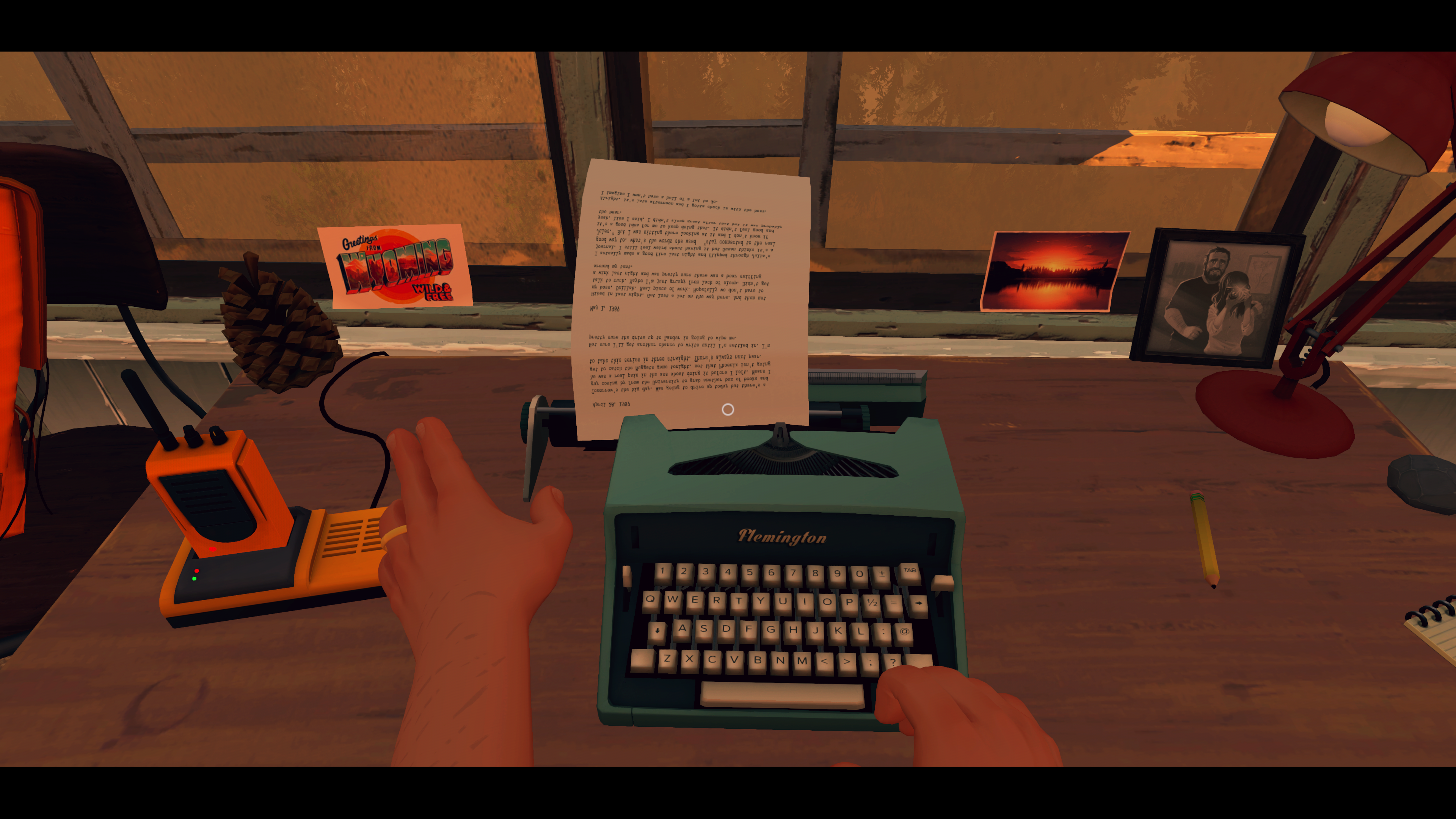
Pixel Boost is our weekly series devoted to the artistry of games, and the techniques required to run them at high resolutions.
Art direction can go a long way in creating a believable videogame world, even if it ignores realism entirely. Firewatch is a prime example, using advanced color theory and scenic framing to render the Shoshone National Forest of Wyoming. The shade of a single tree communicates the time of day and mood while staying recognizable, even silhouetted against a mesh of other props. The same lighting and color spread across every object in the environment is nothing short of astounding, especially in 4K.
Firewatch matches your monitor’s native resolution by default, so to get it running at 4K or higher, you’ll need a 4K monitor (duh) or you’ll need to change your monitor’s rendered resolution to something higher. Nvidia's DSR was a no-go in this case, so we created a custom 4K resolution and ran out desktop at 3840x2160 to grab the screens.
Artists on the Steam forums are already taking some phenomenal wide angle shots. This may not be our last Pixel Boost from the Shoshone.
There’s no way to turn off the massive circular aiming reticule while walking around just yet, which is odd for a game designed to be ogled. Even so, a quick bit of Photoshop work could turn any of these into a wonderful desktop wallpaper.

Pixel Boost is our weekly series devoted to the artistry of games, and the techniques required to run them at high resolutions.
Art direction can go a long way in creating a believable videogame world, even if it ignores realism entirely. Firewatch is a prime example, using advanced color theory and scenic framing to render the Shoshone National Forest of Wyoming. The shade of a single tree communicates the time of day and mood while staying recognizable, even silhouetted against a mesh of other props. The same lighting and color spread across every object in the environment is nothing short of astounding, especially in 4K.
Firewatch matches your monitor’s native resolution by default, so to get it running at 4K or higher, you’ll need a 4K monitor (duh) or you’ll need to change your monitor’s rendered resolution to something higher. Nvidia's DSR was a no-go in this case, so we created a custom 4K resolution and ran out desktop at 3840x2160 to grab the screens.
Artists on the Steam forums are already taking some phenomenal wide angle shots. This may not be our last Pixel Boost from the Shoshone.
There’s no way to turn off the massive circular aiming reticule while walking around just yet, which is odd for a game designed to be ogled. Even so, a quick bit of Photoshop work could turn any of these into a wonderful desktop wallpaper.

Pixel Boost is our weekly series devoted to the artistry of games, and the techniques required to run them at high resolutions.
Art direction can go a long way in creating a believable videogame world, even if it ignores realism entirely. Firewatch is a prime example, using advanced color theory and scenic framing to render the Shoshone National Forest of Wyoming. The shade of a single tree communicates the time of day and mood while staying recognizable, even silhouetted against a mesh of other props. The same lighting and color spread across every object in the environment is nothing short of astounding, especially in 4K.
Firewatch matches your monitor’s native resolution by default, so to get it running at 4K or higher, you’ll need a 4K monitor (duh) or you’ll need to change your monitor’s rendered resolution to something higher. Nvidia's DSR was a no-go in this case, so we created a custom 4K resolution and ran out desktop at 3840x2160 to grab the screens.
Artists on the Steam forums are already taking some phenomenal wide angle shots. This may not be our last Pixel Boost from the Shoshone.
There’s no way to turn off the massive circular aiming reticule while walking around just yet, which is odd for a game designed to be ogled. Even so, a quick bit of Photoshop work could turn any of these into a wonderful desktop wallpaper.

Pixel Boost is our weekly series devoted to the artistry of games, and the techniques required to run them at high resolutions.
Art direction can go a long way in creating a believable videogame world, even if it ignores realism entirely. Firewatch is a prime example, using advanced color theory and scenic framing to render the Shoshone National Forest of Wyoming. The shade of a single tree communicates the time of day and mood while staying recognizable, even silhouetted against a mesh of other props. The same lighting and color spread across every object in the environment is nothing short of astounding, especially in 4K.
Firewatch matches your monitor’s native resolution by default, so to get it running at 4K or higher, you’ll need a 4K monitor (duh) or you’ll need to change your monitor’s rendered resolution to something higher. Nvidia's DSR was a no-go in this case, so we created a custom 4K resolution and ran out desktop at 3840x2160 to grab the screens.
Artists on the Steam forums are already taking some phenomenal wide angle shots. This may not be our last Pixel Boost from the Shoshone.
There’s no way to turn off the massive circular aiming reticule while walking around just yet, which is odd for a game designed to be ogled. Even so, a quick bit of Photoshop work could turn any of these into a wonderful desktop wallpaper.
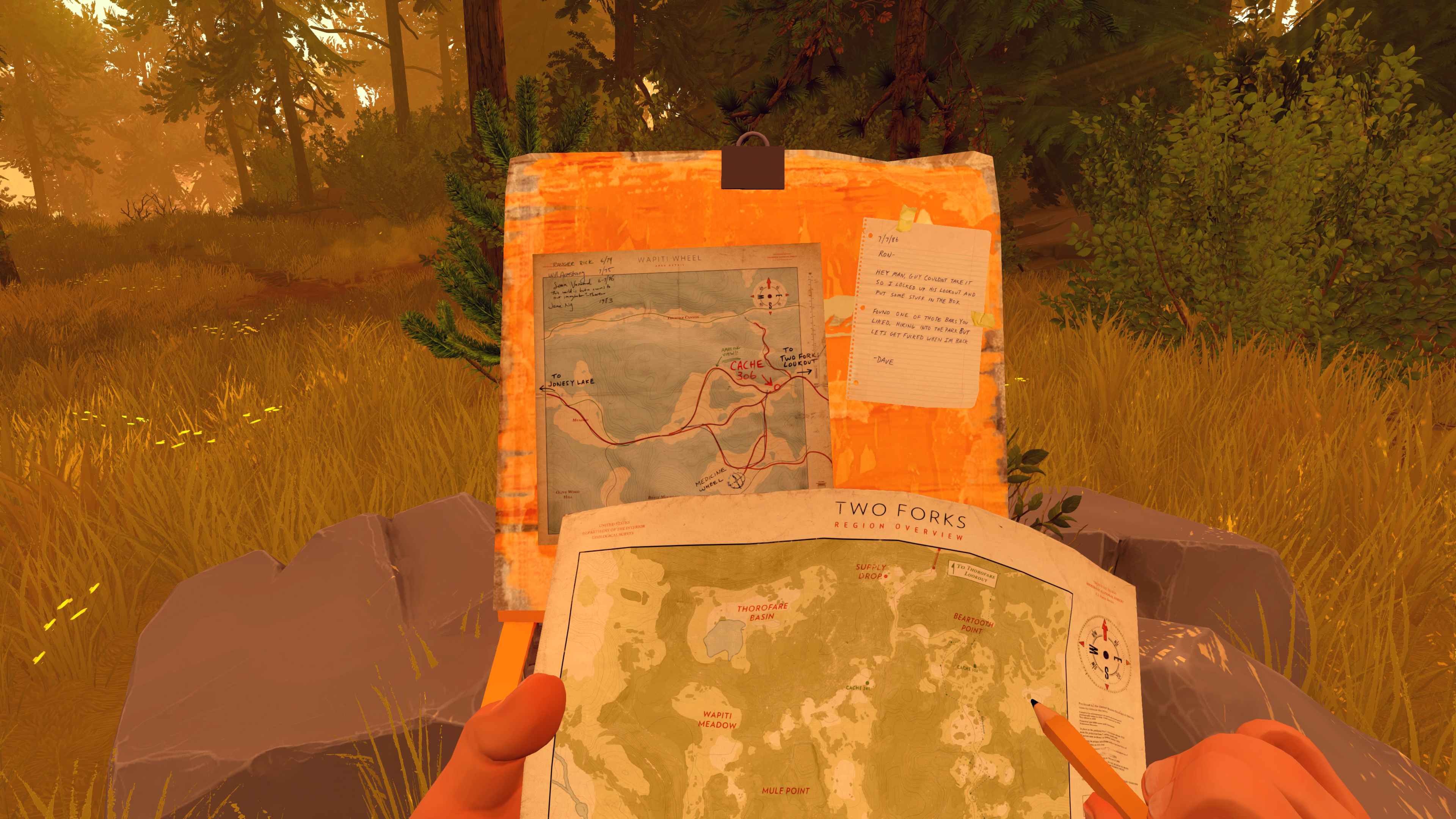
Pixel Boost is our weekly series devoted to the artistry of games, and the techniques required to run them at high resolutions.
Art direction can go a long way in creating a believable videogame world, even if it ignores realism entirely. Firewatch is a prime example, using advanced color theory and scenic framing to render the Shoshone National Forest of Wyoming. The shade of a single tree communicates the time of day and mood while staying recognizable, even silhouetted against a mesh of other props. The same lighting and color spread across every object in the environment is nothing short of astounding, especially in 4K.
Firewatch matches your monitor’s native resolution by default, so to get it running at 4K or higher, you’ll need a 4K monitor (duh) or you’ll need to change your monitor’s rendered resolution to something higher. Nvidia's DSR was a no-go in this case, so we created a custom 4K resolution and ran out desktop at 3840x2160 to grab the screens.
Artists on the Steam forums are already taking some phenomenal wide angle shots. This may not be our last Pixel Boost from the Shoshone.
There’s no way to turn off the massive circular aiming reticule while walking around just yet, which is odd for a game designed to be ogled. Even so, a quick bit of Photoshop work could turn any of these into a wonderful desktop wallpaper.
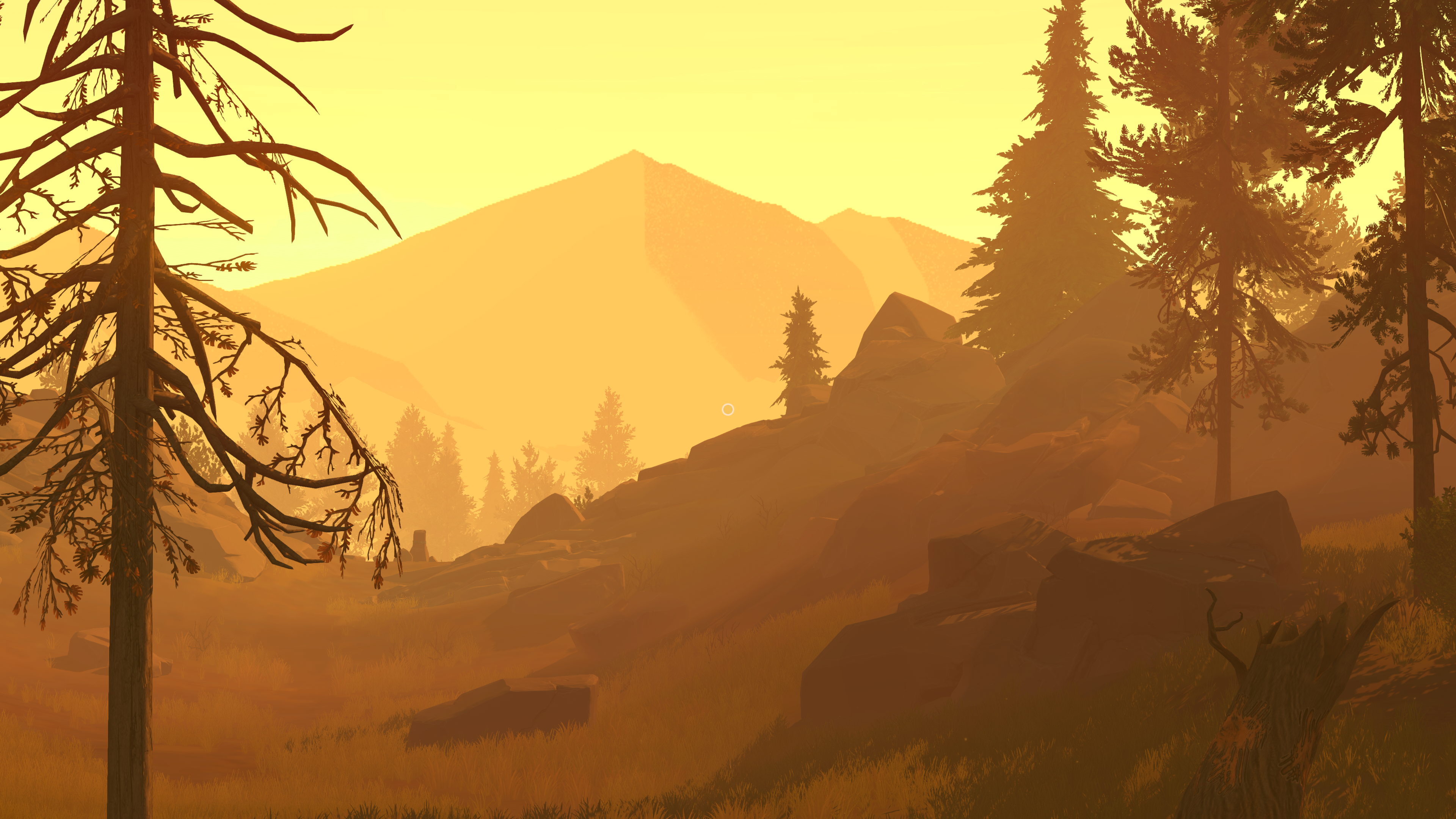
Pixel Boost is our weekly series devoted to the artistry of games, and the techniques required to run them at high resolutions.
Art direction can go a long way in creating a believable videogame world, even if it ignores realism entirely. Firewatch is a prime example, using advanced color theory and scenic framing to render the Shoshone National Forest of Wyoming. The shade of a single tree communicates the time of day and mood while staying recognizable, even silhouetted against a mesh of other props. The same lighting and color spread across every object in the environment is nothing short of astounding, especially in 4K.
Firewatch matches your monitor’s native resolution by default, so to get it running at 4K or higher, you’ll need a 4K monitor (duh) or you’ll need to change your monitor’s rendered resolution to something higher. Nvidia's DSR was a no-go in this case, so we created a custom 4K resolution and ran out desktop at 3840x2160 to grab the screens.
Artists on the Steam forums are already taking some phenomenal wide angle shots. This may not be our last Pixel Boost from the Shoshone.
There’s no way to turn off the massive circular aiming reticule while walking around just yet, which is odd for a game designed to be ogled. Even so, a quick bit of Photoshop work could turn any of these into a wonderful desktop wallpaper.
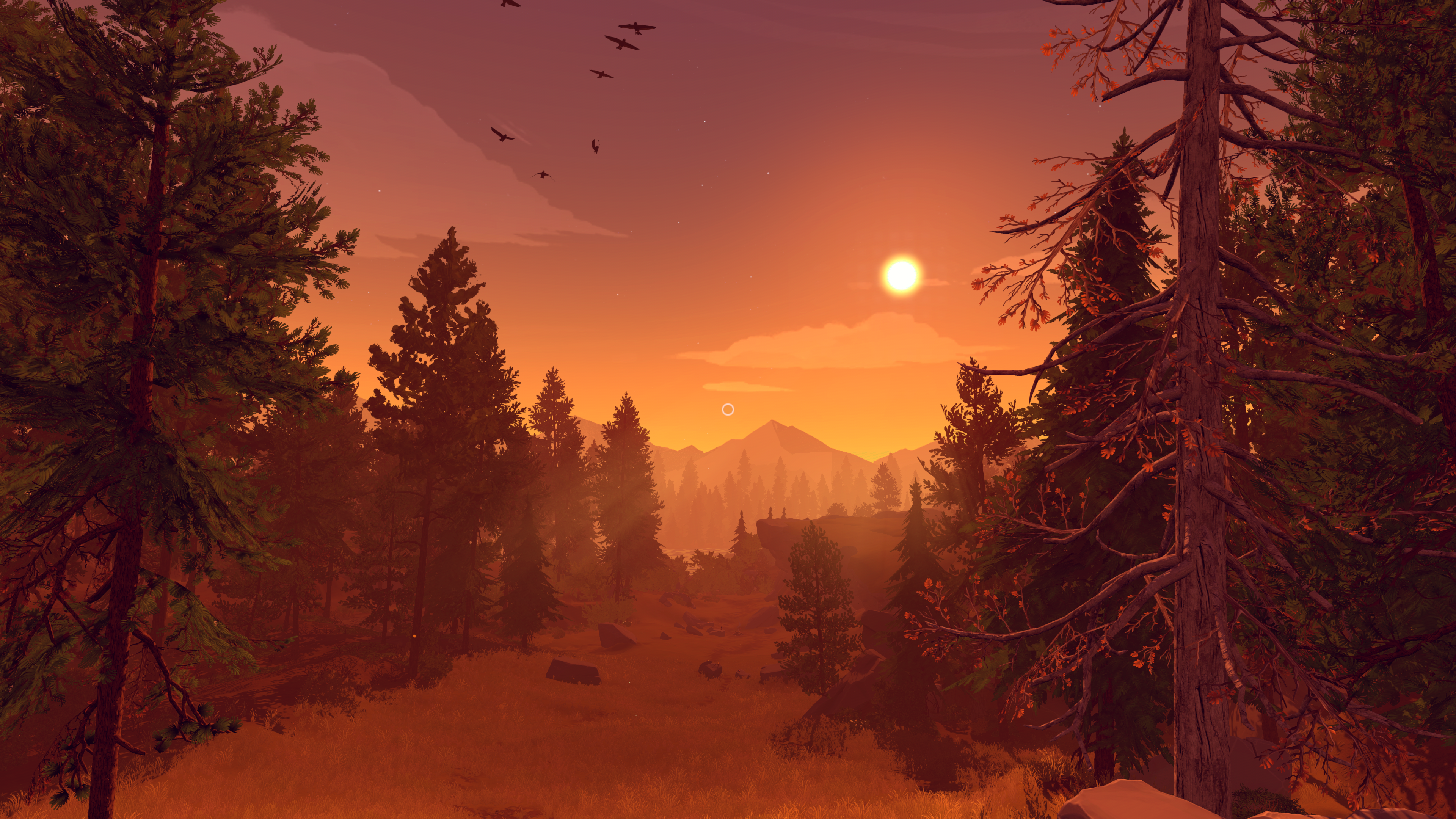
Pixel Boost is our weekly series devoted to the artistry of games, and the techniques required to run them at high resolutions.
Art direction can go a long way in creating a believable videogame world, even if it ignores realism entirely. Firewatch is a prime example, using advanced color theory and scenic framing to render the Shoshone National Forest of Wyoming. The shade of a single tree communicates the time of day and mood while staying recognizable, even silhouetted against a mesh of other props. The same lighting and color spread across every object in the environment is nothing short of astounding, especially in 4K.
Firewatch matches your monitor’s native resolution by default, so to get it running at 4K or higher, you’ll need a 4K monitor (duh) or you’ll need to change your monitor’s rendered resolution to something higher. Nvidia's DSR was a no-go in this case, so we created a custom 4K resolution and ran out desktop at 3840x2160 to grab the screens.
Artists on the Steam forums are already taking some phenomenal wide angle shots. This may not be our last Pixel Boost from the Shoshone.
There’s no way to turn off the massive circular aiming reticule while walking around just yet, which is odd for a game designed to be ogled. Even so, a quick bit of Photoshop work could turn any of these into a wonderful desktop wallpaper.
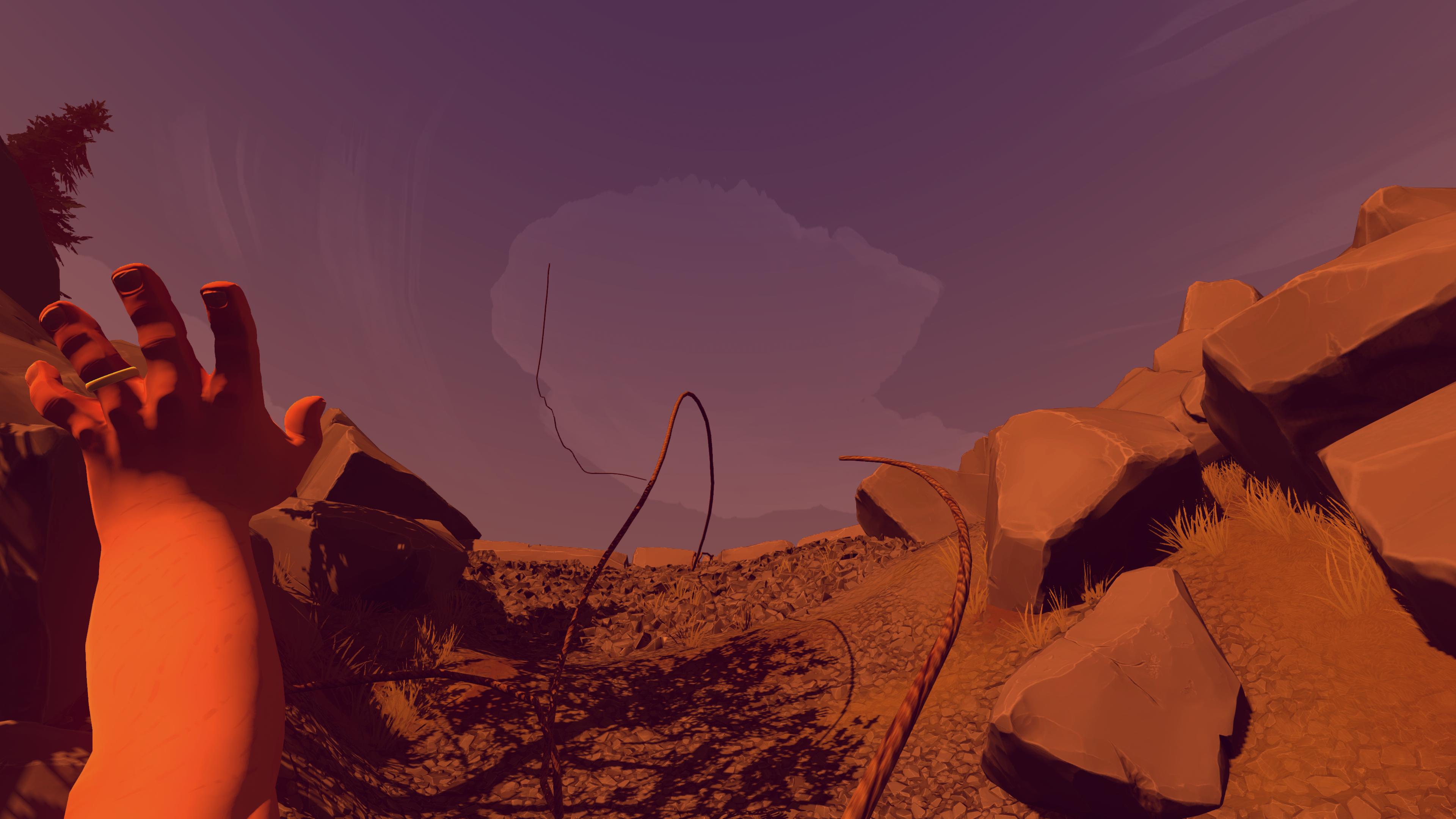
Pixel Boost is our weekly series devoted to the artistry of games, and the techniques required to run them at high resolutions.
Art direction can go a long way in creating a believable videogame world, even if it ignores realism entirely. Firewatch is a prime example, using advanced color theory and scenic framing to render the Shoshone National Forest of Wyoming. The shade of a single tree communicates the time of day and mood while staying recognizable, even silhouetted against a mesh of other props. The same lighting and color spread across every object in the environment is nothing short of astounding, especially in 4K.
Firewatch matches your monitor’s native resolution by default, so to get it running at 4K or higher, you’ll need a 4K monitor (duh) or you’ll need to change your monitor’s rendered resolution to something higher. Nvidia's DSR was a no-go in this case, so we created a custom 4K resolution and ran out desktop at 3840x2160 to grab the screens.
Artists on the Steam forums are already taking some phenomenal wide angle shots. This may not be our last Pixel Boost from the Shoshone.
There’s no way to turn off the massive circular aiming reticule while walking around just yet, which is odd for a game designed to be ogled. Even so, a quick bit of Photoshop work could turn any of these into a wonderful desktop wallpaper.
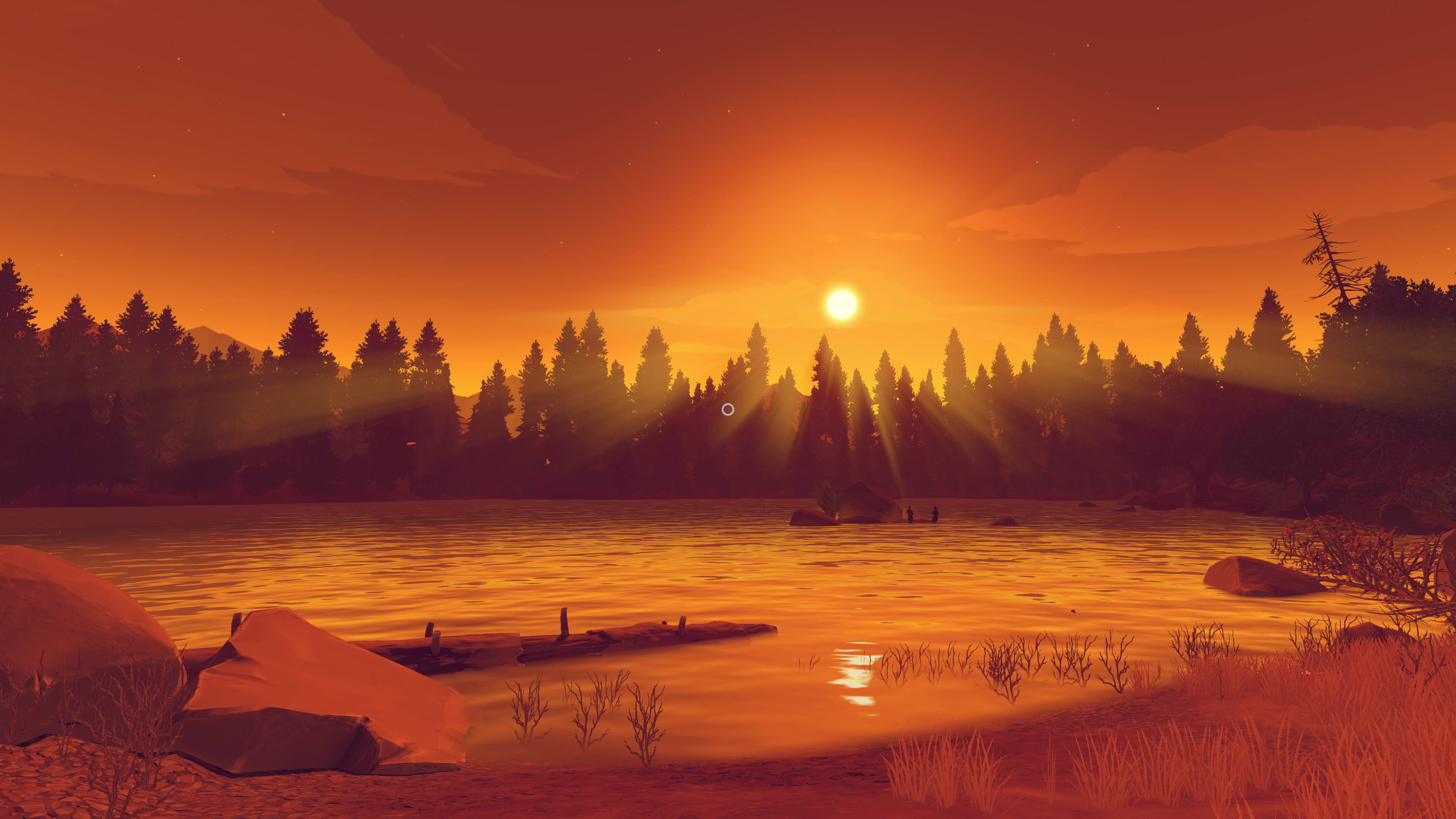
Pixel Boost is our weekly series devoted to the artistry of games, and the techniques required to run them at high resolutions.
Art direction can go a long way in creating a believable videogame world, even if it ignores realism entirely. Firewatch is a prime example, using advanced color theory and scenic framing to render the Shoshone National Forest of Wyoming. The shade of a single tree communicates the time of day and mood while staying recognizable, even silhouetted against a mesh of other props. The same lighting and color spread across every object in the environment is nothing short of astounding, especially in 4K.
Firewatch matches your monitor’s native resolution by default, so to get it running at 4K or higher, you’ll need a 4K monitor (duh) or you’ll need to change your monitor’s rendered resolution to something higher. Nvidia's DSR was a no-go in this case, so we created a custom 4K resolution and ran out desktop at 3840x2160 to grab the screens.
Artists on the Steam forums are already taking some phenomenal wide angle shots. This may not be our last Pixel Boost from the Shoshone.
There’s no way to turn off the massive circular aiming reticule while walking around just yet, which is odd for a game designed to be ogled. Even so, a quick bit of Photoshop work could turn any of these into a wonderful desktop wallpaper.
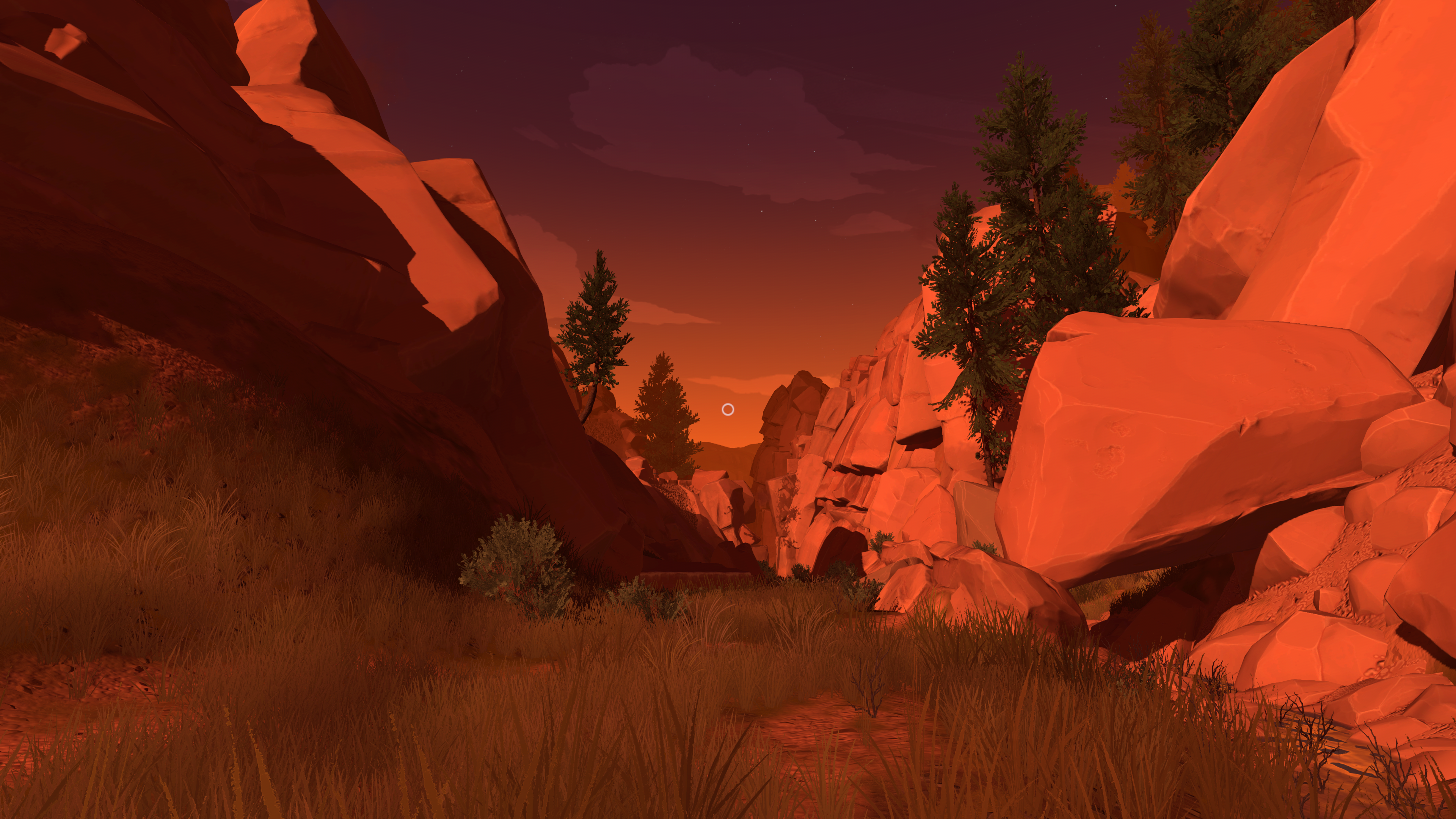
Pixel Boost is our weekly series devoted to the artistry of games, and the techniques required to run them at high resolutions.
Art direction can go a long way in creating a believable videogame world, even if it ignores realism entirely. Firewatch is a prime example, using advanced color theory and scenic framing to render the Shoshone National Forest of Wyoming. The shade of a single tree communicates the time of day and mood while staying recognizable, even silhouetted against a mesh of other props. The same lighting and color spread across every object in the environment is nothing short of astounding, especially in 4K.
Firewatch matches your monitor’s native resolution by default, so to get it running at 4K or higher, you’ll need a 4K monitor (duh) or you’ll need to change your monitor’s rendered resolution to something higher. Nvidia's DSR was a no-go in this case, so we created a custom 4K resolution and ran out desktop at 3840x2160 to grab the screens.
Artists on the Steam forums are already taking some phenomenal wide angle shots. This may not be our last Pixel Boost from the Shoshone.
There’s no way to turn off the massive circular aiming reticule while walking around just yet, which is odd for a game designed to be ogled. Even so, a quick bit of Photoshop work could turn any of these into a wonderful desktop wallpaper.

Pixel Boost is our weekly series devoted to the artistry of games, and the techniques required to run them at high resolutions.
Art direction can go a long way in creating a believable videogame world, even if it ignores realism entirely. Firewatch is a prime example, using advanced color theory and scenic framing to render the Shoshone National Forest of Wyoming. The shade of a single tree communicates the time of day and mood while staying recognizable, even silhouetted against a mesh of other props. The same lighting and color spread across every object in the environment is nothing short of astounding, especially in 4K.
Firewatch matches your monitor’s native resolution by default, so to get it running at 4K or higher, you’ll need a 4K monitor (duh) or you’ll need to change your monitor’s rendered resolution to something higher. Nvidia's DSR was a no-go in this case, so we created a custom 4K resolution and ran out desktop at 3840x2160 to grab the screens.
Artists on the Steam forums are already taking some phenomenal wide angle shots. This may not be our last Pixel Boost from the Shoshone.
There’s no way to turn off the massive circular aiming reticule while walking around just yet, which is odd for a game designed to be ogled. Even so, a quick bit of Photoshop work could turn any of these into a wonderful desktop wallpaper.
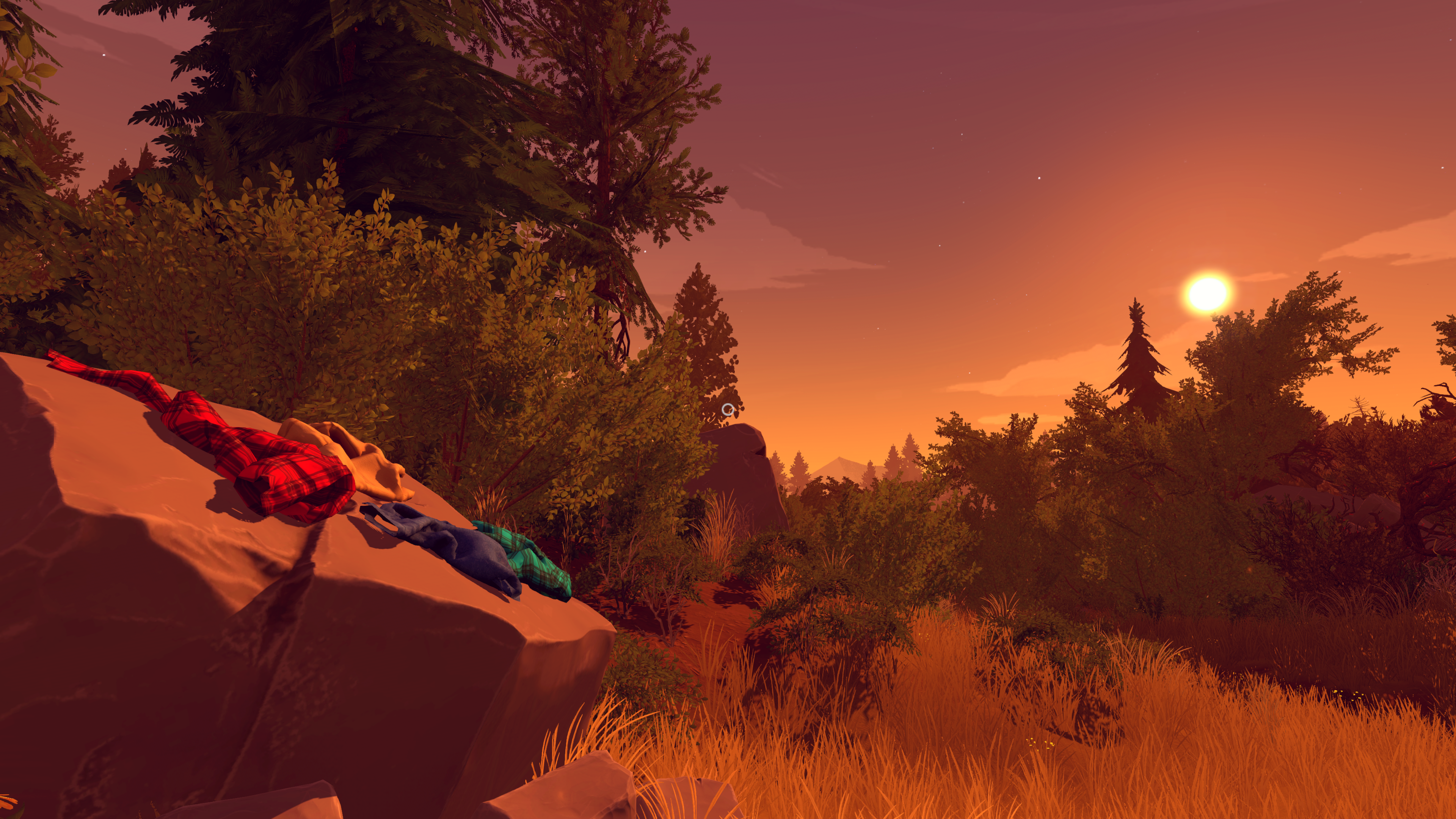
Pixel Boost is our weekly series devoted to the artistry of games, and the techniques required to run them at high resolutions.
Art direction can go a long way in creating a believable videogame world, even if it ignores realism entirely. Firewatch is a prime example, using advanced color theory and scenic framing to render the Shoshone National Forest of Wyoming. The shade of a single tree communicates the time of day and mood while staying recognizable, even silhouetted against a mesh of other props. The same lighting and color spread across every object in the environment is nothing short of astounding, especially in 4K.
Firewatch matches your monitor’s native resolution by default, so to get it running at 4K or higher, you’ll need a 4K monitor (duh) or you’ll need to change your monitor’s rendered resolution to something higher. Nvidia's DSR was a no-go in this case, so we created a custom 4K resolution and ran out desktop at 3840x2160 to grab the screens.
Artists on the Steam forums are already taking some phenomenal wide angle shots. This may not be our last Pixel Boost from the Shoshone.
There’s no way to turn off the massive circular aiming reticule while walking around just yet, which is odd for a game designed to be ogled. Even so, a quick bit of Photoshop work could turn any of these into a wonderful desktop wallpaper.
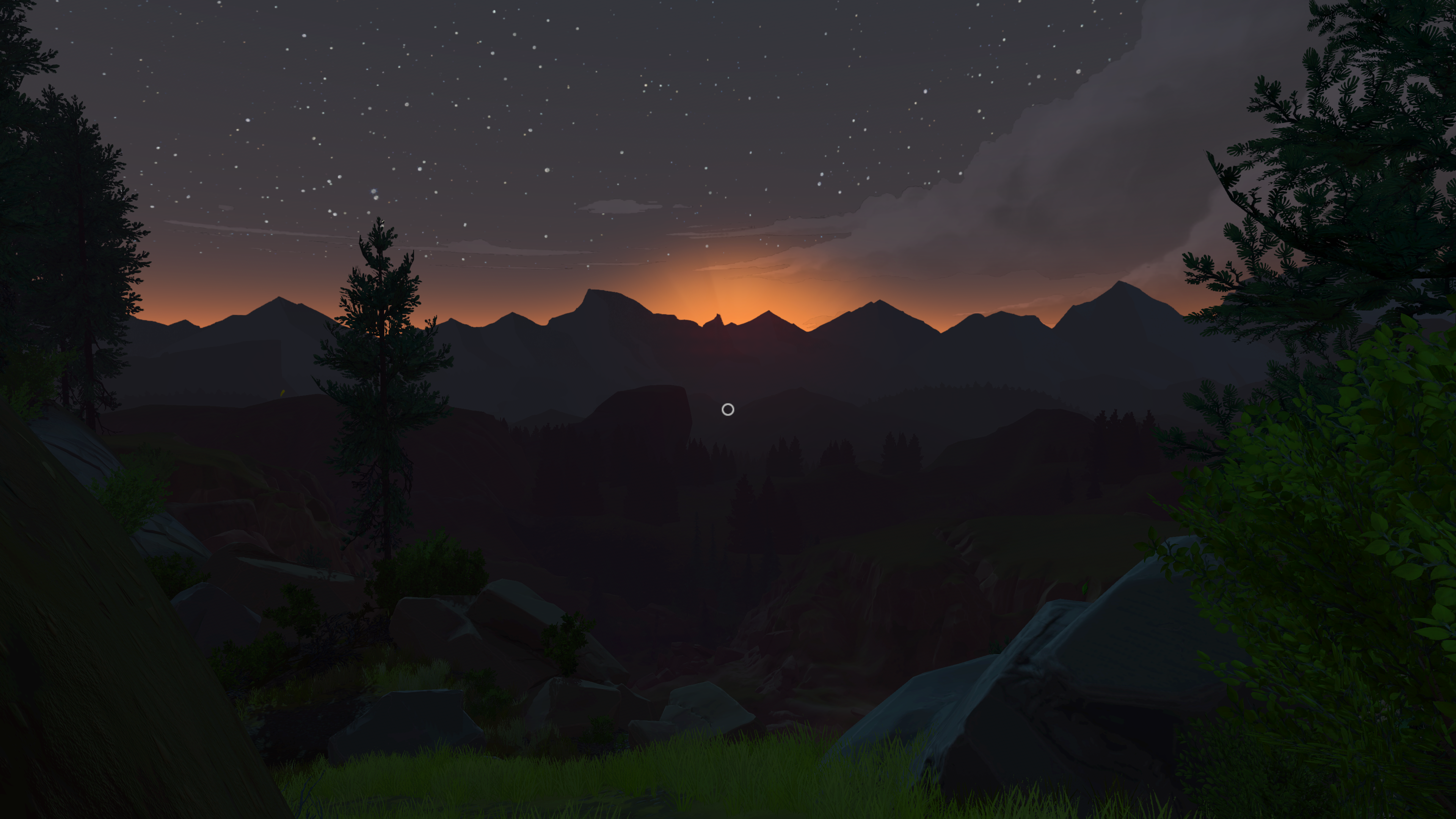
Pixel Boost is our weekly series devoted to the artistry of games, and the techniques required to run them at high resolutions.
Art direction can go a long way in creating a believable videogame world, even if it ignores realism entirely. Firewatch is a prime example, using advanced color theory and scenic framing to render the Shoshone National Forest of Wyoming. The shade of a single tree communicates the time of day and mood while staying recognizable, even silhouetted against a mesh of other props. The same lighting and color spread across every object in the environment is nothing short of astounding, especially in 4K.
Firewatch matches your monitor’s native resolution by default, so to get it running at 4K or higher, you’ll need a 4K monitor (duh) or you’ll need to change your monitor’s rendered resolution to something higher. Nvidia's DSR was a no-go in this case, so we created a custom 4K resolution and ran out desktop at 3840x2160 to grab the screens.
Artists on the Steam forums are already taking some phenomenal wide angle shots. This may not be our last Pixel Boost from the Shoshone.
There’s no way to turn off the massive circular aiming reticule while walking around just yet, which is odd for a game designed to be ogled. Even so, a quick bit of Photoshop work could turn any of these into a wonderful desktop wallpaper.
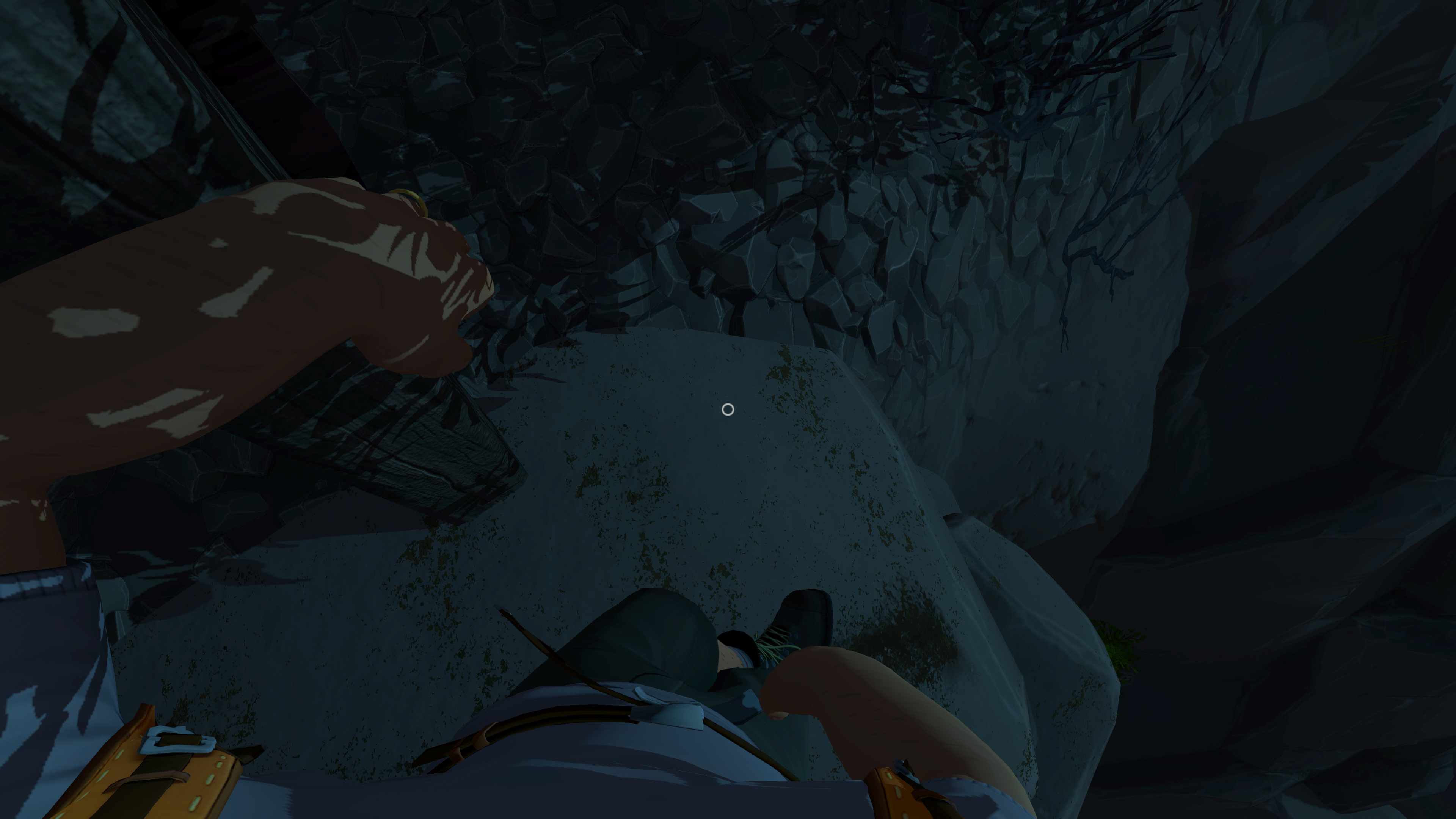
Pixel Boost is our weekly series devoted to the artistry of games, and the techniques required to run them at high resolutions.
Art direction can go a long way in creating a believable videogame world, even if it ignores realism entirely. Firewatch is a prime example, using advanced color theory and scenic framing to render the Shoshone National Forest of Wyoming. The shade of a single tree communicates the time of day and mood while staying recognizable, even silhouetted against a mesh of other props. The same lighting and color spread across every object in the environment is nothing short of astounding, especially in 4K.
Firewatch matches your monitor’s native resolution by default, so to get it running at 4K or higher, you’ll need a 4K monitor (duh) or you’ll need to change your monitor’s rendered resolution to something higher. Nvidia's DSR was a no-go in this case, so we created a custom 4K resolution and ran out desktop at 3840x2160 to grab the screens.
Artists on the Steam forums are already taking some phenomenal wide angle shots. This may not be our last Pixel Boost from the Shoshone.
There’s no way to turn off the massive circular aiming reticule while walking around just yet, which is odd for a game designed to be ogled. Even so, a quick bit of Photoshop work could turn any of these into a wonderful desktop wallpaper.
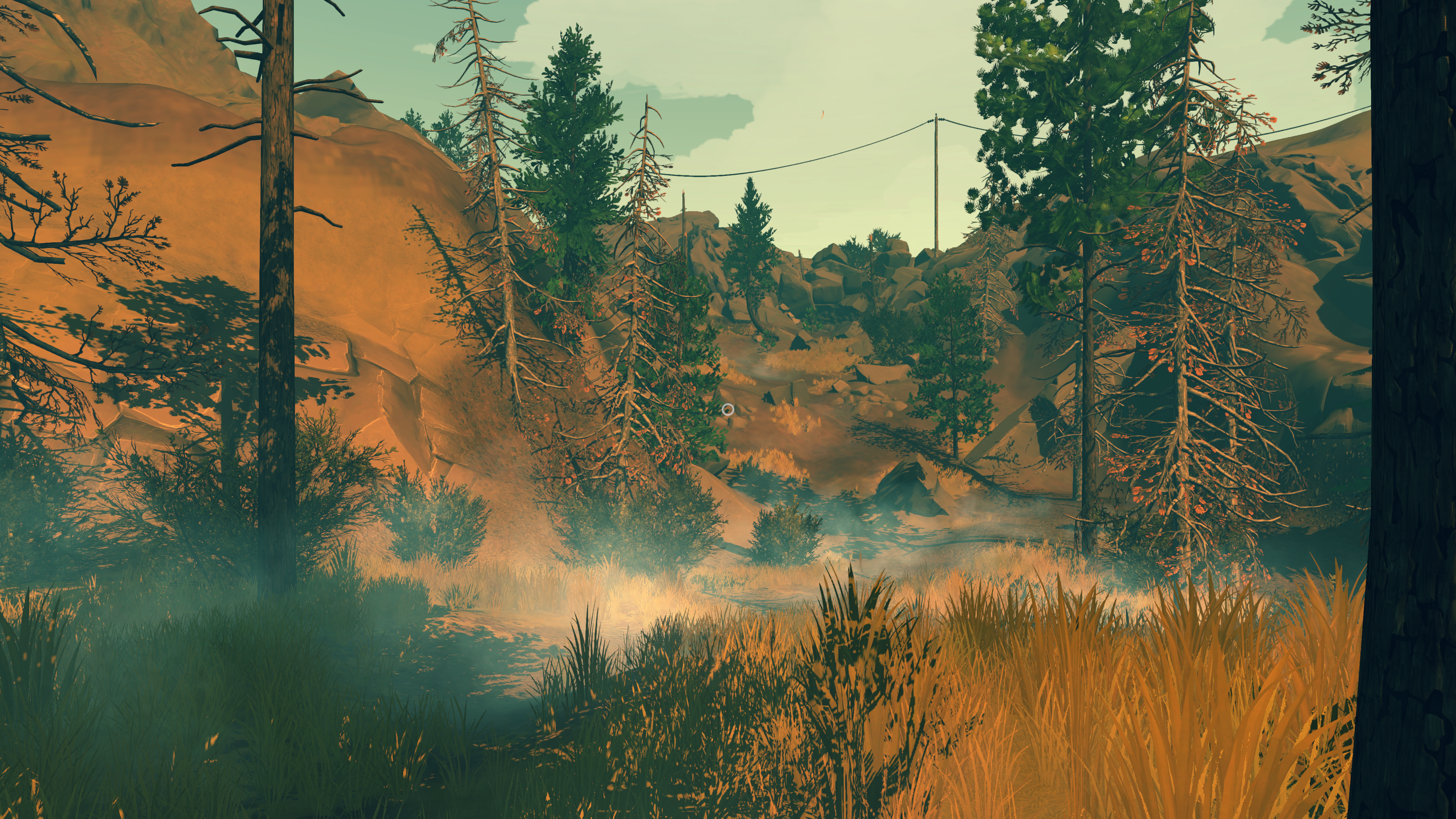
Pixel Boost is our weekly series devoted to the artistry of games, and the techniques required to run them at high resolutions.
Art direction can go a long way in creating a believable videogame world, even if it ignores realism entirely. Firewatch is a prime example, using advanced color theory and scenic framing to render the Shoshone National Forest of Wyoming. The shade of a single tree communicates the time of day and mood while staying recognizable, even silhouetted against a mesh of other props. The same lighting and color spread across every object in the environment is nothing short of astounding, especially in 4K.
Firewatch matches your monitor’s native resolution by default, so to get it running at 4K or higher, you’ll need a 4K monitor (duh) or you’ll need to change your monitor’s rendered resolution to something higher. Nvidia's DSR was a no-go in this case, so we created a custom 4K resolution and ran out desktop at 3840x2160 to grab the screens.
Artists on the Steam forums are already taking some phenomenal wide angle shots. This may not be our last Pixel Boost from the Shoshone.
There’s no way to turn off the massive circular aiming reticule while walking around just yet, which is odd for a game designed to be ogled. Even so, a quick bit of Photoshop work could turn any of these into a wonderful desktop wallpaper.

Pixel Boost is our weekly series devoted to the artistry of games, and the techniques required to run them at high resolutions.
Art direction can go a long way in creating a believable videogame world, even if it ignores realism entirely. Firewatch is a prime example, using advanced color theory and scenic framing to render the Shoshone National Forest of Wyoming. The shade of a single tree communicates the time of day and mood while staying recognizable, even silhouetted against a mesh of other props. The same lighting and color spread across every object in the environment is nothing short of astounding, especially in 4K.
Firewatch matches your monitor’s native resolution by default, so to get it running at 4K or higher, you’ll need a 4K monitor (duh) or you’ll need to change your monitor’s rendered resolution to something higher. Nvidia's DSR was a no-go in this case, so we created a custom 4K resolution and ran out desktop at 3840x2160 to grab the screens.
Artists on the Steam forums are already taking some phenomenal wide angle shots. This may not be our last Pixel Boost from the Shoshone.
There’s no way to turn off the massive circular aiming reticule while walking around just yet, which is odd for a game designed to be ogled. Even so, a quick bit of Photoshop work could turn any of these into a wonderful desktop wallpaper.
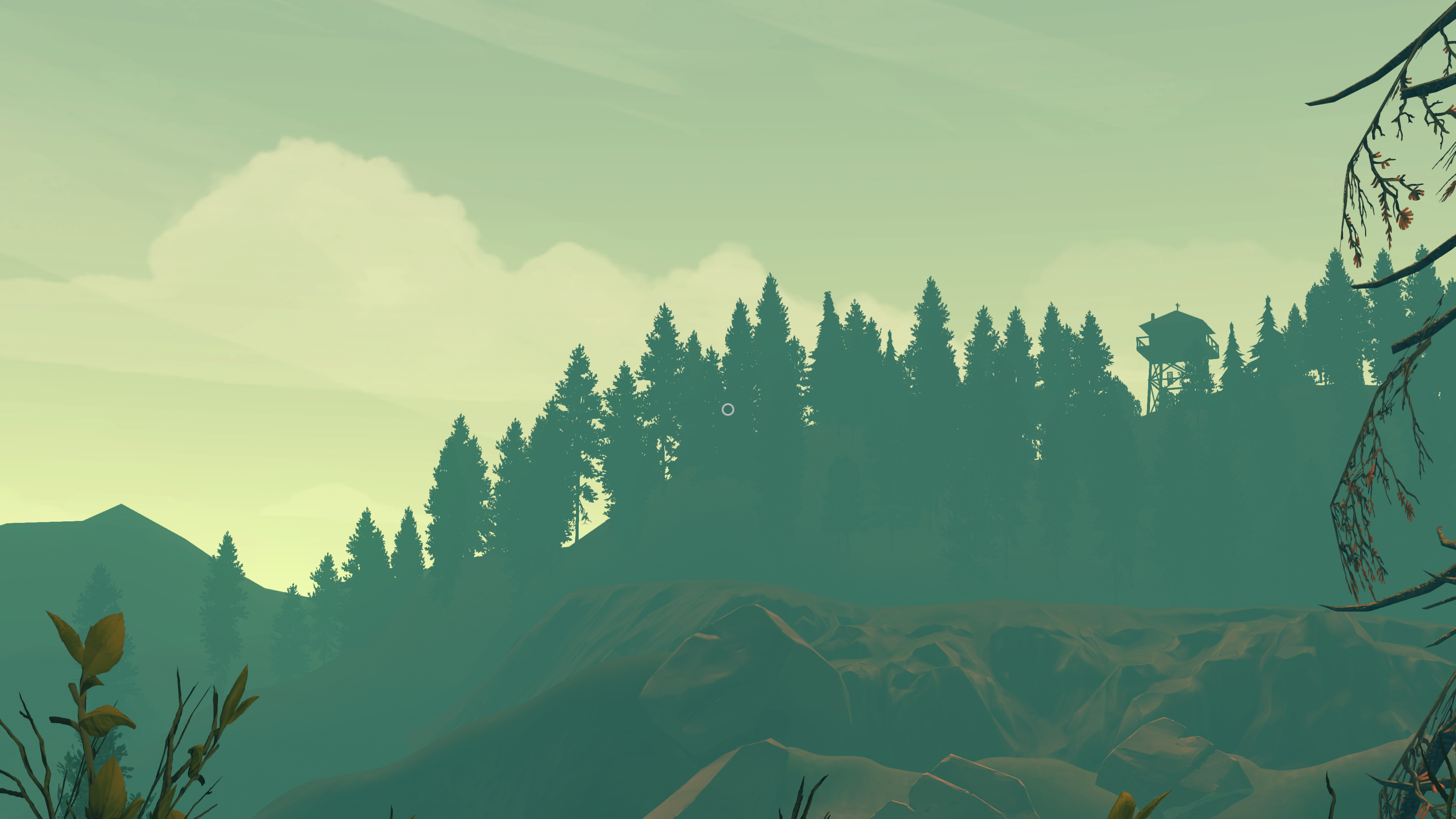
Pixel Boost is our weekly series devoted to the artistry of games, and the techniques required to run them at high resolutions.
Art direction can go a long way in creating a believable videogame world, even if it ignores realism entirely. Firewatch is a prime example, using advanced color theory and scenic framing to render the Shoshone National Forest of Wyoming. The shade of a single tree communicates the time of day and mood while staying recognizable, even silhouetted against a mesh of other props. The same lighting and color spread across every object in the environment is nothing short of astounding, especially in 4K.
Firewatch matches your monitor’s native resolution by default, so to get it running at 4K or higher, you’ll need a 4K monitor (duh) or you’ll need to change your monitor’s rendered resolution to something higher. Nvidia's DSR was a no-go in this case, so we created a custom 4K resolution and ran out desktop at 3840x2160 to grab the screens.
Artists on the Steam forums are already taking some phenomenal wide angle shots. This may not be our last Pixel Boost from the Shoshone.
There’s no way to turn off the massive circular aiming reticule while walking around just yet, which is odd for a game designed to be ogled. Even so, a quick bit of Photoshop work could turn any of these into a wonderful desktop wallpaper.
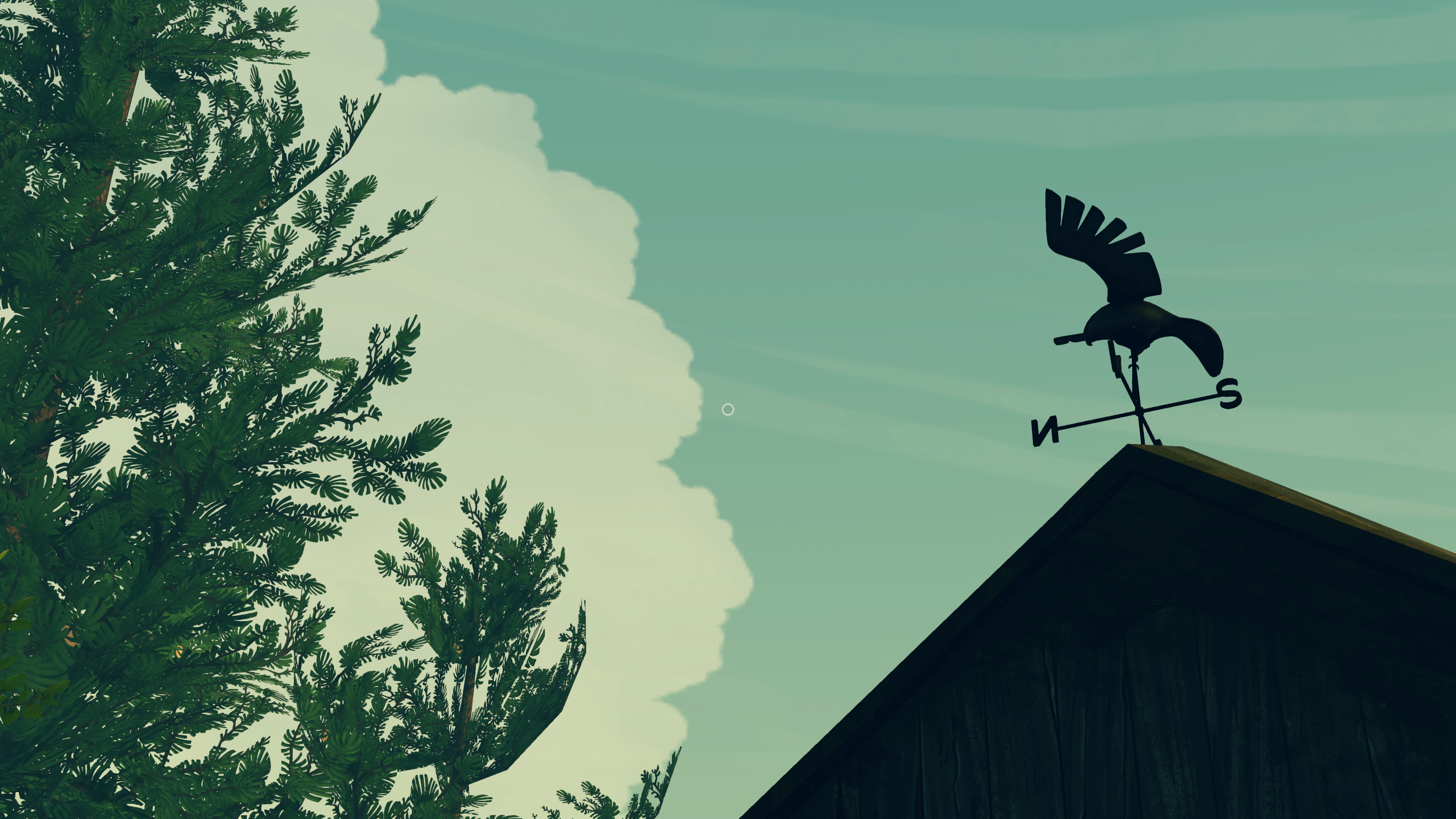
Pixel Boost is our weekly series devoted to the artistry of games, and the techniques required to run them at high resolutions.
Art direction can go a long way in creating a believable videogame world, even if it ignores realism entirely. Firewatch is a prime example, using advanced color theory and scenic framing to render the Shoshone National Forest of Wyoming. The shade of a single tree communicates the time of day and mood while staying recognizable, even silhouetted against a mesh of other props. The same lighting and color spread across every object in the environment is nothing short of astounding, especially in 4K.
Firewatch matches your monitor’s native resolution by default, so to get it running at 4K or higher, you’ll need a 4K monitor (duh) or you’ll need to change your monitor’s rendered resolution to something higher. Nvidia's DSR was a no-go in this case, so we created a custom 4K resolution and ran out desktop at 3840x2160 to grab the screens.
Artists on the Steam forums are already taking some phenomenal wide angle shots. This may not be our last Pixel Boost from the Shoshone.
There’s no way to turn off the massive circular aiming reticule while walking around just yet, which is odd for a game designed to be ogled. Even so, a quick bit of Photoshop work could turn any of these into a wonderful desktop wallpaper.
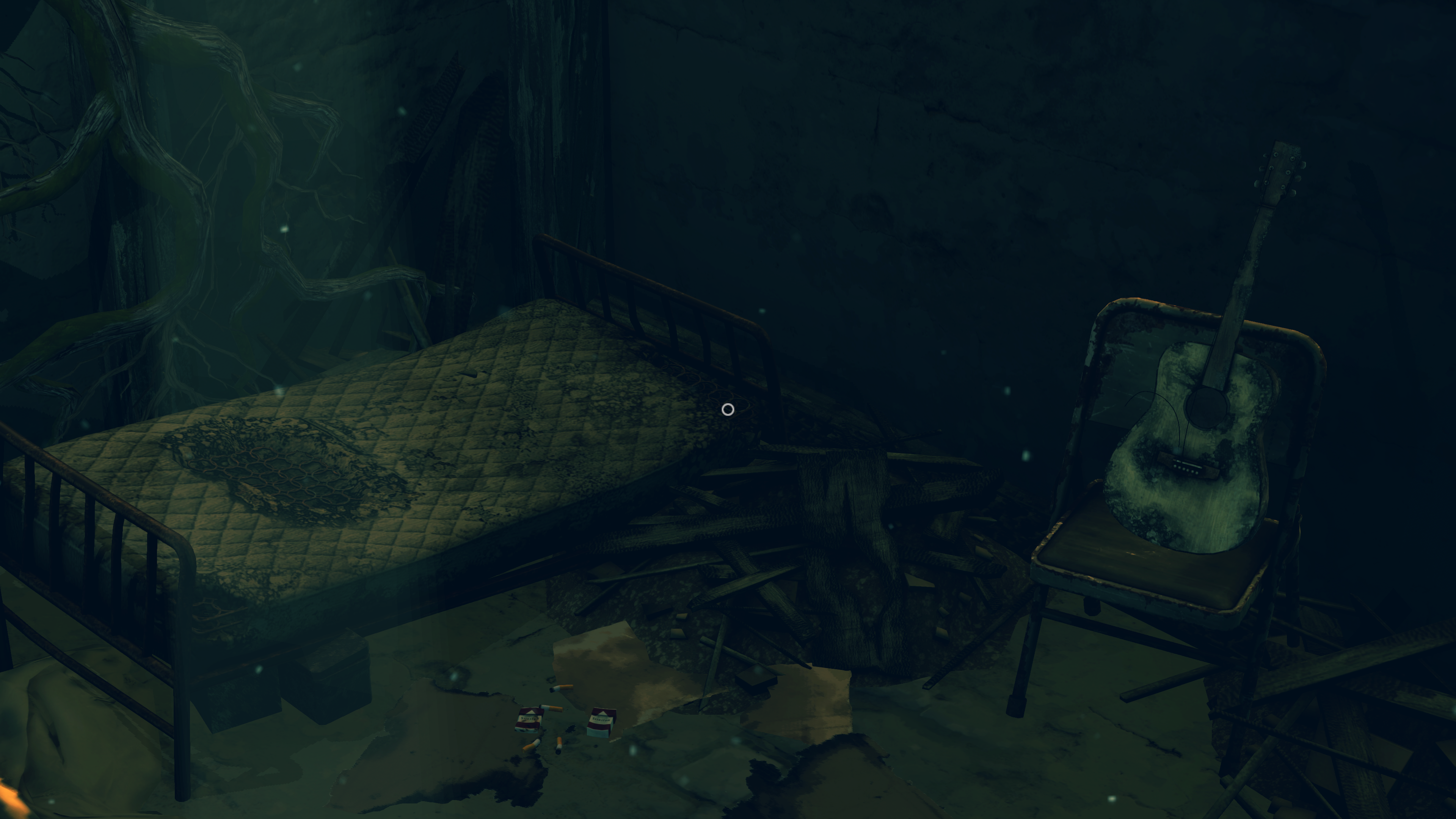
Pixel Boost is our weekly series devoted to the artistry of games, and the techniques required to run them at high resolutions.
Art direction can go a long way in creating a believable videogame world, even if it ignores realism entirely. Firewatch is a prime example, using advanced color theory and scenic framing to render the Shoshone National Forest of Wyoming. The shade of a single tree communicates the time of day and mood while staying recognizable, even silhouetted against a mesh of other props. The same lighting and color spread across every object in the environment is nothing short of astounding, especially in 4K.
Firewatch matches your monitor’s native resolution by default, so to get it running at 4K or higher, you’ll need a 4K monitor (duh) or you’ll need to change your monitor’s rendered resolution to something higher. Nvidia's DSR was a no-go in this case, so we created a custom 4K resolution and ran out desktop at 3840x2160 to grab the screens.
Artists on the Steam forums are already taking some phenomenal wide angle shots. This may not be our last Pixel Boost from the Shoshone.
There’s no way to turn off the massive circular aiming reticule while walking around just yet, which is odd for a game designed to be ogled. Even so, a quick bit of Photoshop work could turn any of these into a wonderful desktop wallpaper.
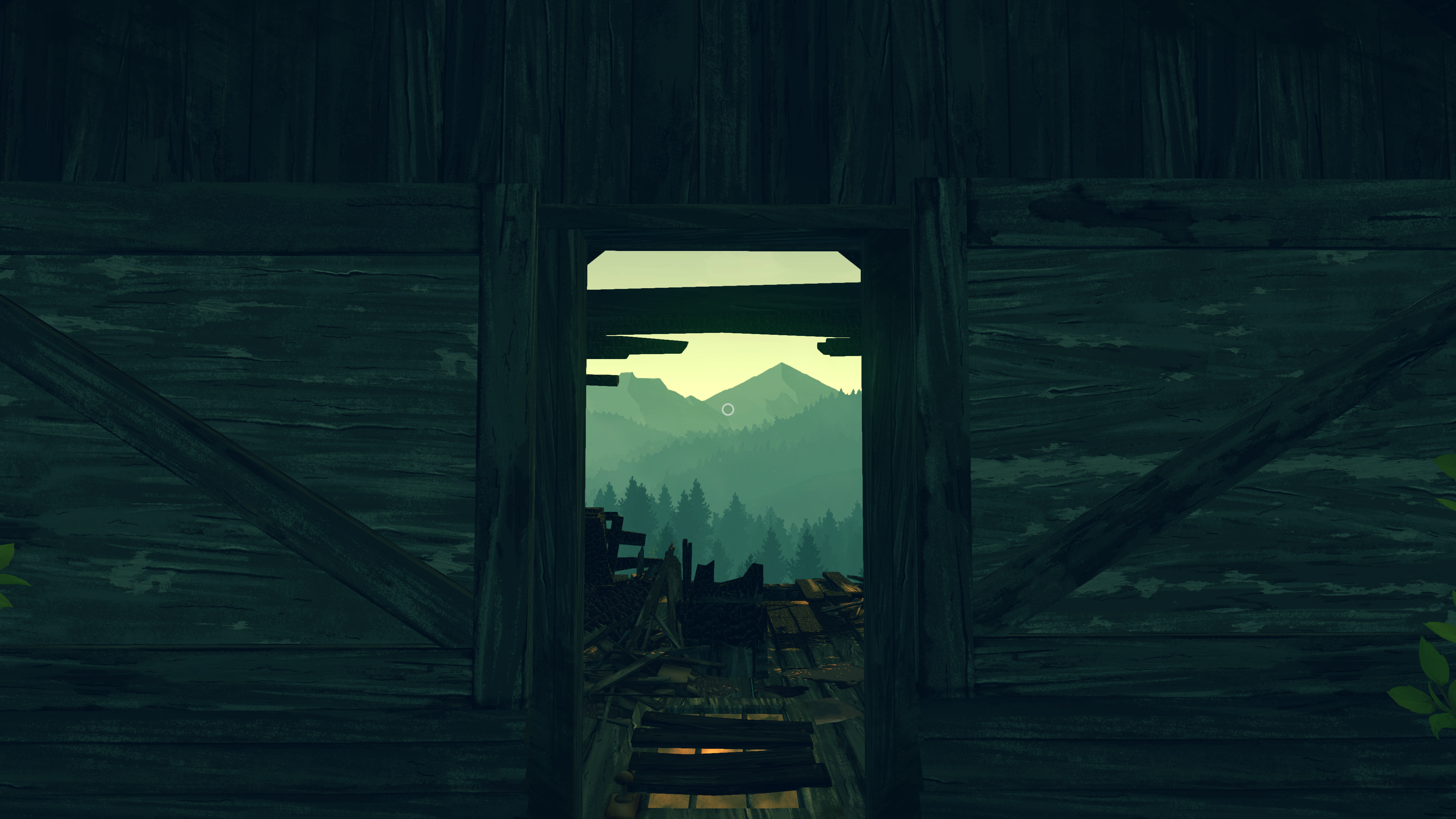
Pixel Boost is our weekly series devoted to the artistry of games, and the techniques required to run them at high resolutions.
Art direction can go a long way in creating a believable videogame world, even if it ignores realism entirely. Firewatch is a prime example, using advanced color theory and scenic framing to render the Shoshone National Forest of Wyoming. The shade of a single tree communicates the time of day and mood while staying recognizable, even silhouetted against a mesh of other props. The same lighting and color spread across every object in the environment is nothing short of astounding, especially in 4K.
Firewatch matches your monitor’s native resolution by default, so to get it running at 4K or higher, you’ll need a 4K monitor (duh) or you’ll need to change your monitor’s rendered resolution to something higher. Nvidia's DSR was a no-go in this case, so we created a custom 4K resolution and ran out desktop at 3840x2160 to grab the screens.
Artists on the Steam forums are already taking some phenomenal wide angle shots. This may not be our last Pixel Boost from the Shoshone.
There’s no way to turn off the massive circular aiming reticule while walking around just yet, which is odd for a game designed to be ogled. Even so, a quick bit of Photoshop work could turn any of these into a wonderful desktop wallpaper.

Pixel Boost is our weekly series devoted to the artistry of games, and the techniques required to run them at high resolutions.
Art direction can go a long way in creating a believable videogame world, even if it ignores realism entirely. Firewatch is a prime example, using advanced color theory and scenic framing to render the Shoshone National Forest of Wyoming. The shade of a single tree communicates the time of day and mood while staying recognizable, even silhouetted against a mesh of other props. The same lighting and color spread across every object in the environment is nothing short of astounding, especially in 4K.
Firewatch matches your monitor’s native resolution by default, so to get it running at 4K or higher, you’ll need a 4K monitor (duh) or you’ll need to change your monitor’s rendered resolution to something higher. Nvidia's DSR was a no-go in this case, so we created a custom 4K resolution and ran out desktop at 3840x2160 to grab the screens.
Artists on the Steam forums are already taking some phenomenal wide angle shots. This may not be our last Pixel Boost from the Shoshone.
There’s no way to turn off the massive circular aiming reticule while walking around just yet, which is odd for a game designed to be ogled. Even so, a quick bit of Photoshop work could turn any of these into a wonderful desktop wallpaper.
PC Gamer is the global authority on PC games—starting in 1993 with the magazine, and then in 2010 with this website you're currently reading. We have writers across the US, Canada, UK and Australia, who you can read about here.


